
How an emphasis on people and culture is building business MAY 2023 Special Section: CRE Top Projects around the Valley Social Media in Finance Video as Content Marketing This Month’s Guest Editor Essen Otu Salt River Project THIS ISSUE Arizona Technology Council $7.95 INBUSINESSPHX.COM Counterfeit Vulnerability in e-Commerce Beyond Just Talk
The health and well-being of your employees matters. UnitedHealthcare is here to help you guide them toward brighter days ahead. From finding new ways of controlling costs to connecting them with medical care and mental health support, it’s good to have a health plan that’s on their side and in your corner.

Insurance coverage provided by or through UnitedHealthcare Insurance Company or its affiliates. Administrative services provided by United HealthCare Services, Inc. or their affiliates. Health Plan coverage provided by or through UnitedHealthcare of Arizona, Inc. B2B EI211205447.0 12/21 © 2021 United HealthCare Services, Inc. All Rights Reserved. 21-1202769-A
at uhc.com
Learn more
we’ll find new possibilities
Together,
New grads for a new economy
Accelerating innovation

By 2032, Arizona State University will be graduating 10,000 engineering students per year. Those graduates will be needed to fill the high-tech, high-wage jobs being created in Arizona through the New Economy Initiative. Building on ASU’s role as a catalyst for economic growth and resilience, the New Economy Initiative prioritizes accessible, high-quality education to create Arizona’s future workforce and innovative research that helps to attract, grow and retain high-tech companies.
 Aliaksandr “Sasha” Sharstniou (right) and Bruno Azeredo, an assistant professor of manufacturing engineering. Sharstniou is preparing to begin a new position at Intel in Arizona after earning his doctorate in materials science and engineering from the Ira A. Fulton Schools of Engineering.
Aliaksandr “Sasha” Sharstniou (right) and Bruno Azeredo, an assistant professor of manufacturing engineering. Sharstniou is preparing to begin a new position at Intel in Arizona after earning his doctorate in materials science and engineering from the Ira A. Fulton Schools of Engineering.
neweconomy.asu.edu
GUEST COLUMNISTS
40 OPTUM FOR OPTIMAL HEALTH OVER 55
This month spotlighting Optum, Tyler Butler’s series explores the myriad ways businesses give back and the positive ways their programs impact our community.
42
LISTENING IS THE FIRST STEP
Bruce Weber’s series examines developing and sustaining organizational capacity.
FEATURES
32 All Video Is Video Content Marketing
Patrick McGowan offers five rules for greater reach.
44 Use an Advisory Board to Benefit a Business
Rick Jackson discusses how businesses can tap into seasoned and impartial experts.
DEPARTMENTS
9 Guest Editor Essen Otu, Manager of Diversity, Equity and Inclusion at Salt River Project, introduces the “DEI” issue.
10 Feedback
Jill Chasson, Leila Gimino and Ivan Royal respond to In Business Magazine’s burning business question of the month.
11 Briefs
“Workplace Accidents Liability,” “Dailies Top Stories,” “Local Standouts Recognized for Achievements and Philanthropy,” “Global Economy Could Benefit from More PMPs” and “Electric Fireplace Tech Revolutionizing the Industry”
COVER STORY
24 Beyond Just Talk: How an emphasis on people and culture is building business
In Business Magazine takes the pulse of DEI in the workplace with input from businesses in varied sectors of our business community, from healthcare to workforce development to technology.

18 From the Top
Evolving with the times, Andy Fegley leads Phoenix REALTORS® to become a benchmark among industry associations.

20 Healthcare
“Urgent Care Service for Skin Care” and “Start the Mental Health Conversation”
22 Technology
“Artificial Intelligence and Bias in the Insurance Industry” and “Prep Proactively for Emerging AI”
33 Books
New releases give fresh insights on business thinking.

34 En Negocios
Feature articles in Spanish and English on Economia / Economy
36 Economy
Elizabeth Hale discusses how business owners can develop a strategic plan to position their business for acquisition.
38 Legal
47 Arizona Technology Council
13 By the Numbers
The concept of nondisruptive creation is about new growth and opportunity without confronting industry players.
14 Startups
“Your Patient’s Advocate Helps Individuals Navigate the Healthcare System” and “The Journey Disrupts with Diversity in Venture Funding”
15 CRE
53 CRE Top Projects

“Novus Innovation Corridor,” “Listening Facilitated Successful Logistics Center Construction,” “Camelback Corridor Renovation to Redefine the Modern Workplace” and “Repurposed CRE Elevates Design for Health Clinic”
Attorney Hani Sayed shares strategies to stay alert as so much business is transitioning to E-commerce — and ward off counterfeits.
43 Nonprofit
Sam Leyvas discusses the influence and impact of small businesses on the community.
45 Assets
2023 Mercedes-Maybach S 580 4MATIC Plus: Cultural Asset Strengthens Our Community

46 Power Lunch
PHX Beer Co.’s Downtown Taproom Puts the Brewery on View
66 Roundtable
Emmanuel Daniel discusses the potential of social media to transform banking.
The nearly 15,000 women working in STEM occupations in Phoenix represented the 6th-largest female STEM workforce among the 47 Western U.S. cities in CommercialCafé’s recent study.
commercialcafe.com/blog/best-u-s-cities-for-women-stem
INBUSINESSPHX.COM MAY 2023
4
President’s Message Arizona Technology Report The Voice of the Technology Industry SPECIAL
PARTNER SECTION
SECTION CRE TOP PROJECTS
MAY 2023













HEREYOUAREAZ.COM Visit a new state of mind. Where time is measured in moments, not minutes. 36.04586° N, 112.05867° W
In Business Magazine is a collaboration of many business organizations and entities throughout the metropolitan Phoenix area and Arizona. Our mission is to inform and energize business in this community by communicating content that will build business and enrich the economic picture for all of us vested in commerce.
PARTNER ORGANIZATIONS

Kristen Merrifield, CEO Alliance of Arizona Nonprofits (602) 279-2966 www.arizonanonprofits.org

Debbie Hann, Chief Operating Officer Arizona Small Business Association Central Office (602) 306-4000 www.asba.com
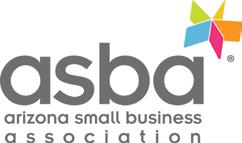
Steven G. Zylstra, President & CEO Arizona Technology Council One Renaissance Square (602) 343-8324 www.aztechcouncil.org
Doug Bruhnke, Founder & President Global Chamber® (480) 595-5000 www.globalchamber.org
Ania Kubicki , President NAWBO Phoenix Metro Chapter (480) 289-5768 www.nawbophx.org
Colin Diaz, President & CEO Tempe Chamber of Commerce (480) 967-7891 www.tempechamber.org
Our Partner Organizations are vested business organizations focused on building and improving business in the Valley or throughout Arizona. As Partners, each will receive three insert publications each year to showcase all that they are doing for business and businesspeople within our community. We encourage you to join these and other organizations to better your business opportunities. The members of these and other Associate Partner Organizations receive a subscription to In Business Magazine each month. For more information on becoming an Associate Partner, please contact our publisher at info@inbusinessphx.com
ASSOCIATE PARTNERS
Ahwatukee Foothills Chamber of Commerce ahwatukeechamber.com
Arizona Chamber of Commerce & Industry azchamber.com
Arizona Hispanic Chamber of Commerce azhcc.com
The Black Chamber of Arizona phoenixblackchamber.com
Chandler Chamber of Commerce chandlerchamber.com Economic Club of Phoenix econclubphx.org
Glendale Chamber of Commerce glendaleazchamber.org
Greater Phoenix Chamber of Commerce phoenixchamber.com
Greater Phoenix Equality Chamber of Commerce gpglcc.org
Mesa Chamber of Commerce mesachamber.org
North Phoenix Chamber of Commerce northphoenixchamber.com
Peoria Chamber of Commerce peoriachamber.com
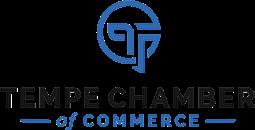
Phoenix Metro Chamber of Commerce phoenixmetrochamber.com
Scottsdale Area Chamber of Commerce scottsdalechamber.com

Scottsdale Coalition of Today and Tomorrow (SCOTT) scottnow.com
Surprise Regional Chamber of Commerce surpriseregionalchamber.com
WESTMARC westmarc.org
6 INBUSINESSPHX.COM MAY 2023
May 2023 VOL. 14, NO. 5 Don’t pay more for doing more business. Member
Lender Learn More, Visit StearnsBank.com /Phoenix BusinessEssentials™ checking. NEW
FDIC Equal Housing
MEET YOUR NEWEST EMPLOYEE A SMART THERMOSTAT.


Finding opportunities to lower expenses is part of running a business. So is keeping your business comfortable for your customers and employees. With the SRP Bring Your own Thermostat Program™ (BYOT), you can do both with ease. When you enroll in BYOT, you can receive energy-saving smart thermostats for free and get paid for each one you install. You can even use the smart features of your thermostat to monitor energy usage and monthly savings. BYOT doesn’t just help your business, it also helps keep Arizona’s grid reliable by automatically adjusting thermostats during a few conservation events a year.
Find out more about the benefits of SRP’s BYOT program at srp.net/bizbyot.
571751 02/23
Words
RaeAnne Marsh
Editor, In Business Magazine
RaeAnne Marsh became editorial director of Phoenix-based InMedia Company in 2010 and helped launch Valley-wide business resource In Business Magazine. Her journalism career began more than 20 years ago, when she left California and 12 years of teaching to transplant in Phoenix’s vibrant entrepreneurial environment, and includes incorporating her own business, Grammar & Glitz, Inc., through which she has taken writing and editing gigs with business and media clients nationwide. Holding the magazine to strong editorial standards, she says, “New businesses are founded, out-of-staters bring new strengths, established businesses evolve and expand — all of which contributes to the dynamic vitality that I see as the mission of In Business Magazine to be the voice of and vehicle to nurture, in each monthly edition. It is my challenge to ensure each edition is packed with relevant information on a broad spectrum of issues, aimed at a readership that runs the gamut from entrepreneurial startup to major corporation.”
Edgar R. Olivo Editor, En Negocios
As editor of the Spanish section of In Business Magazine, Edgar R. Olivo shares weekly content for Spanish-preferred small-business owners in Phoenix. As a first-generation Latinx and native-Arizonan, Olivo’s upbringing was filled with similar challenges that Latino communities in Arizona face when they engage with the economy. An entrepreneur and nonprofit executive, he is leading the charge to help strengthen a diverse, inclusive and sustainable entrepreneurial ecosystem in Arizona. His work is nationally recognized for establishing programs that help advance equitable economic recovery, and increase generational wealth for Latinx/Hispanic small business owners in Arizona.
“I believe today is a moment for leading big change. Business ownership is a critical means to build community and individual wealth. I hope my work will demonstrate to the Latino community that the entrepreneur ecosystem in Arizona has their back.”
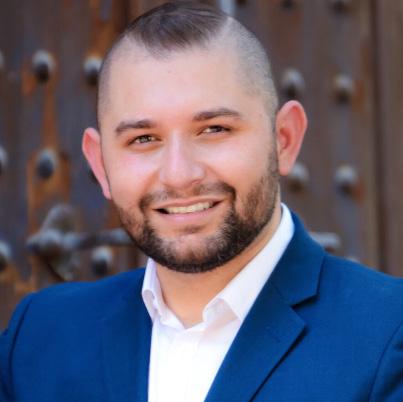
Guest columns are feature articles presented as a special, limited series as well as regular, ongoing series in In Business Magazine.
Tyler Butler
Guest Columnist – Social Impact

A long time corporate social responsibility practitioner, Tyler Butler is known for her expertise in creating, launching and developing successful social impact programs. Her commitment to rallying people together to make a positive difference has created sustainable signature programs empowering people to give back in a myriad of ways globally. Butler operates under the ethos of “each one teach one,” and so her contributions to In Business Magazine provide her with an outlet to share the best of what companies are doing to aid humanity. Butler looks to shed light on good corporate citizens and share stories about the magic they are creating through their generous outreach efforts.
Don Henninger
Guest Columnist – Metro
As a 35-year newspaper veteran in Arizona, Don Henninger has always made journalism his passion as well as his career. Facts matter — especially in this day and age — and information is the foundation that enables citizens to be positive participants in their communities at all levels. Henninger has been fortunate to serve as a community leader and continues in that role today as director of the Scottsdale Coalition of Today & Tomorrow, which convenes leaders to work on issues in that city, and as a member of several nonprofit boards in the Valley.
Bruce Weber
Guest Columnist – Capacity
Bruce Weber sees In Business Magazine as a valuable forum for topics relevant to our business and nonprofit community. “I am deeply interested in organizational capacity and what makes organizations successful and impactful in the work they do. In my work in the community for more than 16 years, I have worked with all sizes of organizations and leaders in helping their businesses grow and expand their impact. My previous careers with Microsoft and Hewlett Packard involved working with business integration partners to design strategies to engage new markets. In today’s complex world, I enjoy exploring the possibilities and opportunities that change can bring.”
Publisher Rick McCartney


Editor RaeAnne Marsh
En Negocios Editor Edgar Rafael Olivo
Web Editor Jake Kless
Graphic Design Benjamin Little
CONTRIBUTING WRITERS
Christophe Bourguignat
Tyler Butler
Emmanuel Daniel
Charley Freericks
Elizabeth Hale
Mike Hunter
Rick Jackson
W. Chan Kim
Michelle LaBrosse
Sam Leyvas
Mary Little
Renée Mauborgne
Patrick McGowan
Hani Sayed
Jonathan Shroyer
Dmitry Tokar
Bruce Weber
Adam Wojcik
ADVERTISING
Operations Louise Ferrari
Business Development Louise Ferrari
Cami Shore
Events Amy Corben
More: Visit your one-stop resource for everything business at inbusinessphx.com. For a full monthly calendar of business-related events, please visit our website.
Inform Us: Send press releases and your editorial ideas to editor@inbusinessphx.com
President & CEO Rick McCartney
Editorial Director RaeAnne Marsh

Financial Manager Tom Beyer
Office Manager Allie Jones
Accounting Manager Todd Hagen
Corporate Office InMedia Company 45 W. Jefferson Street Phoenix, AZ 85003
T: (480) 588-9505 info@inmediacompany.com www.inmediacompany.com
Vol. 14, No. 5 In Business Magazine is published 12 times per year by InMedia Company. POSTMASTER: Send address changes to InMedia Company, 45 W. Jefferson Street, Phoenix, AZ 85003. To subscribe to In Business Magazine, please send check or money order for one-year subscription of $24.95 to InMedia Company, 45 W. Jefferson Street, Phoenix, AZ 85003 or visit inbusinessphx.com. We appreciate your editorial submissions, news and photos for review by our editorial staff. You may send to editor@inbusinessmag.com or mail to the address above. All letters sent to In Business Magazine will be treated as unconditionally assigned for publication, copyright purposes and use in any publication, website or brochure. InMedia accepts no responsibility for unsolicited manuscripts, photographs or other artwork. Submissions will not be returned unless accompanied by a self-addressed, stamped envelope. InMedia Company, LLC reserves the right to refuse certain advertising and is not liable for advertisers’ claims and/or errors. The opinions expressed herein are exclusively those of the writers and do not necessarily reflect the position of InMedia. InMedia Company considers its sources reliable and verifies as much data as possible, although reporting inaccuracies can occur; consequently, readers using this information do so at their own risk. Each business opportunity and/ or investment inherently contains certain risks, and it is suggested that the prospective investors consult their attorney and/or financial professional. ©2022 InMedia Company, LLC. All rights reserved. No part of this magazine may be reproduced or transmitted in any form or by any means without written permission by any means without written permission by the publisher.
8 INBUSINESSPHX.COM MAY 2023
OUR CONTENT CREATORS
May 2023
Essen Otu is the manager of Diversity, Equity and Inclusion (DEI) at Salt River Project, where he is responsible for providing corporate leadership for DEI in support of business objectives and corporate goals. Prior to Joining SRP, Otu spent more than 10 years in the healthcare industry with progressive roles overseeing D&I and as senior director of Diversity & Community Affairs. He received his undergraduate degree from ASU and graduate degree from Baruch College in New York through the National Urban Fellows Program. srpnet.com
Opportunities of Inclusion
We are living in an exciting time in history, both in Arizona and around the world, as diversity, equity and inclusion (DEI) are being recognized as critical in the business world. DEI as a concept is about celebrating, harnessing and respecting individual differences and creating environments that maximize human potential in everyone. When this is done right, individuals and companies can successfully put that into play with their own unique business function and workforce.
Arizona’s increasingly diverse demographics, generational workforce transitions, changing employee and customer values and expectations contribute heavily to the importance of DEI as a factor in a company’s responsiveness and agility. This need for agility is required to adapt to the evolving needs of customers, employees and the communities in which they live and work. This also presents a unique opportunity for a positive DEI impact within the corporate landscape. Research shows businesses that meaningfully invest in DEI efforts will see measurable outcomes relative to better decision making and attracting as well as retaining top talent and innovation. As a result, they will ultimately reap the benefits of longevity and relevance.
At SRP, we aspire to harness the power of diversity, inclusion and belonging to build a more equitable and sustainable future for our customers, employees and communities. It is that longterm DEI vision that has driven our commitment and fuels our journey.
In Business Magazine works to take the pulse on this movement with input from businesses in varied sectors of our business community, from healthcare to workforce development to technology. They open up about the philosophy they bring to their inclusion programs and the real and substantive impact they are seeing on their operations.
Video has become ubiquitous in our lives — and its place in business has spread beyond the standard sales infomercial. In this month’s feature, “All Video Is Video Content Marketing,” Patrick McGowan explains why businesses need to keep their brand image in mind whenever the camera is on — and match the message to the platform presenting it.
Social media has gotten a lot of attention for how it has been transforming many aspects of our lives. The Roundtable feature takes a look at one that is commonly overlooked: banking. As he discusses that in his article, “The Information Is the Product,” Emmanuel Daniel also considers the potential that social media offers to this vital business sector.
Offering its usual range of strong, relevant business content, this May edition also includes a healthcare article on mental health and a technology article on ethics concerns in the use of Artificial Intelligence, an Economy feature on how best to position your business for acquisition, and a By the Numbers on the positive force of disruptive businesses.
I’ve worked with In Business Magazine previously as it has covered the topic of diversity, equity and inclusion, and I’m very pleased to help create this May edition. I hope you find it a useful resource.
Sincerely,

Rubber Meeting the Road
Essen Otu Manager of Diversity, Equity and Inclusion Salt River Project

For years, what we now term DEI has been something that few have consciously addressed within their organizations. Today, we are all talking about it. So, when we set out to do another cover story on DEI, we said we want to go beyond the talk and see what is happening and the impact those efforts are having on people and culture. In this edition of In Business Magazine, we get started on this journey to better communicate and point to those actions that are making a difference where it comes to building culture that is good for everyone in the company and including the people
and their experience to empower the organization, as an example. Few better to lead this edition that Essen Otu. His work at SRP day to day is a lived experience that we knew would help us to catapult into the discussion for this cover story.
We thank him for all that he does for the people of SRP and for our community. He is a true leader and does so much to bring all of us along with him. —Rick McCartney, Publisher

EN NEGOCIOS
Manténgase informado sobre temas empresariales en español a través de En Negocios, artículos para los lectores de habla hispana en el área metropolitana de Phoenix. Visite inbusinessphx.com/ ennegocios para más información.

Stay informed on business topics in Spanish through En Negocios, articles for Spanish-speaking readers in the Phoenix metropolitan area. Visit inbusinessphx.com/ ennegocios for more information.

9 INBUSINESSPHX.COM MAY 2023 CONNECT WITH US: Story Ideas/PR: editor@ inbusinessphx.com Business Events/ Connections: businessevents@ inbusinessphx.com Marketing/Exposure: advertise@ inbusinessphx.com Visit us online at www.inbusinessphx.com Let us know what you think of this issue of In Business Magazine. Email our publisher at feedback@inbusinessphx.com DON’T MISS OUT! Get a year of In Business Magazine Subscribe now at inbusinessphx.com Section: Top Organizations Must ‘Flatlining’ Strategies Dangers ‘Quiet Promotion’ This Guest Kate Authority ISSUE Requirements Privacy WhyBrick-and-Mortar Businesses Booming RetailonTop
Photo courtesy of
ESSEN OTU, SALT RIVER PROJECT
FEEDBACK
QUESTION: Let
What have you found to be the highlight of your DEI/DEIB efforts in terms of implementation and/or results?
LEILA GIMINO
Partner
Coppersmith Brockelman
Sector: Law
When Andy Gordon and Sam Coppersmith started Coppersmith Brockelman in 1995, no one used the term “DEI.” Back then, traditional law firm recruiting typically meant hiring candidates who looked, acted and thought like everyone else at the firm. But Coppersmith recognized that traditional recruiting would make the firm both less interesting and less capable. It would be more engaging and better suited to help clients if it recruited people who did not have the same blind spots as everyone else at the firm.
Ever since, Coppersmith has welcomed diverse viewpoints and experiences and offered the flexibility to accommodate that diversity. Its commitment to DEI, however, extends beyond recruitment and to every aspect of the firm, especially attorney development. Coppersmith does not apply a one-size-fits-all approach to attorney success. Instead, it supports its attorneys as they build unique practices based on their individual experiences and capabilities. This commitment to DEI from recruitment to development has allowed Coppersmith to retain diverse attorneys and staff, attract additional diverse talent and serve diverse clients.
Coppersmith Brockelman, PLC cblawyers.com
Jill Chasson is partner and chair of Coppersmith Brockelman’s governance committee. She focuses on helping businesses of all sizes in a variety of industries with their employment law needs. She provides practical advice to employers regarding compliance with the many federal and state laws that govern the workplace and regularly provides training for supervisors and human resource professionals.
Legal & Compliance Lead – West Region Vice Chair of MMA West DE&I Council Lovitt & Touché, A Marsh & McLennan Agency LLC Company Sector: Insurance



One of the things that we work on with our DE&I initiatives, especially in terms of allyship — which refers to the process of building and nurturing supportive relationships with underrepresented, marginalized or discriminated individuals or groups with the aim of advancing inclusion — is listening. When we’re in a group of people or participating in one of our colleague resource groups, we focus on not centering the discussion on ourselves and our experiences.
There is so much noise out there around what privilege is and isn’t. But in our initiatives and discussions with our colleagues, we’re learning to cut out all that noise and truly listen to each other. Another huge benefit of these efforts around intentional listening is that colleagues from all walks of life and backgrounds are embracing the space and opportunity to speak up and share their voices with the understanding that they will be heard and respected.
Lovitt & Touché, A Marsh & McLennan Agency LLC Company lovitt-touche.com
An experienced paralegal with a demonstrated history of working in the insurance and legal industries, Leila Gimino serves as the Legal & Compliance lead for Lovitt & Touché, A Marsh & McLennan Agency LLC Company. She also serves as vice chair of the MMA West DE&I Council, working with colleagues to elevate and implement DE&I initiatives.
IVAN ROYAL President
OMEX in Arizona
Sector: Janitorial Service
OMEX’s DEI/DEIB efforts have had a significant impact on the company’s workforce, particularly with the recent formation of an all-female Operations Management team that includes Hispanic, Black and White members. This diverse leadership team is a first for our Arizonabased commercial cleaning company in six years and has helped to increase the level of comfort and connection among employees from different backgrounds. One example is the hiring of a female Hispanic leader, who has been able to communicate effectively in both English and Spanish, making it easier for employees from similar backgrounds to connect with her and feel heard. This has helped to foster a sense of inclusivity and belonging within the workforce. With 40% of OMEX’s workforce being Hispanic, the company’s commitment to DEI/DEIB initiatives has been critical in ensuring that all employees feel valued and supported. By prioritizing diversity and inclusivity, OMEX has created a workplace culture that encourages innovation, collaboration and growth for all employees, regardless of their background or identity.
OMEX in Arizona omexcorp.com/phoenix
Ivan Royal is president of OMEX in Arizona, a Tempe-based commercial cleaning company. In addition to providing strategic direction, Royal oversees all operations, including business development, technological initiatives and customer service practices. A thoughtful and established leader with a 21-year distinguished career in the United States Army, he has curated a team of 80 professionals who are trusted to maintain governmental, educational and corporate institutions.
10 INBUSINESSPHX.COM MAY 2023 Sign up for the monthly In Business Magazine eNewsletter at www.inbusinessphx.com. Look for survey questions and other research on our business community.
all past Feedbacks go online to inbusinessphx.com
see what Valley executives think on various business topics.
For
and
us know what you want to know from the Valley’s top business leaders.
editor@inbusinessphx.com
JILL CHASSON
SPEAKING OUT
Workplace Accidents Liability
A workplace accident that results in serious injury or death is both an employer’s and employee’s worst fear. An average 2.8 workers out of every 100 in the U.S. are injured every year. If a worker’s injury is caused by someone else’s negligence, it is extremely important for them to make a workers’ compensation claim as soon as possible.
Not only can workplace accidents directly impact workers’ health and safety, but also the workforce as a whole, losing team members and potentially incurring financial losses if cases are taken to court.
Slips, trips and falls are the top cause of all workers’ compensation claims, incurring injuries such as broken bones, sprains, cuts, pulled muscles, and damage to the back, head and neck. Whilst these types of injuries are described as “nonfatal,” they can result in hospitalization and missed workdays, often resulting in financial losses.

Below are the five most common causes of workplace injuries that would be eligible for pre-settlement funding:
Slip-and-fall accidents — If someone failed to place warning signs around slippery areas or left debris in a walkway, someone could easily fall because of their carelessness. Slipand-fall accidents can result in a back injury, broken bones or a concussion.
Malfunctioning equipment — Many jobs involve machinery that could be faulty or
worn down. Manufacturers and maintenance personnel are obligated to ensure that the work equipment employees use will not cause injuries like accidental amputation or burns. Inadequate training — The employer is responsible for training employees on all the processes necessary to do their job safely. If an employee is injured because this training was not provided or was inadequate, the employer may be liable for the employee’s losses.
Exposure to harmful substances — Contact with dangerous chemicals, excessive radiation levels or scalding liquid can lead to severe burns or even long-term illnesses such as cancer. The employer, supervisor and co-workers must all follow proper safety procedures to ensure employees are not injured at work by these substances.
Excessive noise — A consistently loud environment like a factory or construction site can impact short-term and long-term hearing. Employers must provide workers with training and proper protective equipment to guard against hearing damage that could affect their quality of life. —High Rise Financial (www.highriselegalfunding.com), a pre-settlement legal funding company providing victims of personal injury cases with a portion of their anticipated settlement funds before their case officially settles
DAILIES TOP STORIES
‘In Business Dailies’ Most Views Last 30 Days
Here are the stories with the most views over the past 30 days (prior to press time) that were features in our In Business Dailies. The In Business Dailies hit email inboxes twice each weekday — at 9:30 a.m. and updated at 4:30 p.m. Sign up today at www.inbusinessphx.com/dailies-signup.
Healthcare & Wellness | Cover Story | April 2023
Healthcare Collaborations:
Building Business and Empowering Healthcare
by RaeAnne Marsh
“Healthcare is better when we work together,” says Brian Elisco, Arizona Group CEO for Abrazo Health Abrazo, Elisco notes, collaborates with community physicians, each of whom must also be in the business of running a medical practice; shares medical and technological information through forums open to providers from Abrazo’s as well as other health systems; and has business and community leaders serving on its hospitals’ boards of governors, providing valuable input on local healthcare needs. He points also to Arizona’s colleges and universities as important collaborators with Abrazo’s healthcare system.
Commercial Real Estate & Development | Guest Columnists | April 2023 Office
as a Destination
by Hannah Hackathorn
It’s been proven that we can work anywhere. For many of us, all our basic work tools fit in a backpack or briefcase, and the pandemic really pushed us to be open to new and unexpected work locations. Because of this experience of flexibility, it’s clear that as we transition back to the office, workers are seeking a spectrum of experiences beyond the traditional desk. The definition of “destination” is a place that people will make a special trip to visit, and by providing these new workspace experiences, we’re showing that it’s possible to make the office a destination.
Healthcare & Wellness | Healthcare | March 2023
Mental Health Matters: Employees Expect More from Their Health Benefits
by Joe Greenberg
Employee expectations have drastically shifted over the past few years.
Employees now have baseline expectations for the health insurance benefits their employers offer. Their desires have evolved beyond traditional health insurance benefits for emergencies, outpatient or inpatient coverage to specific needs that support their mental health since COVID-19 exacerbated mental health conditions.
Google searches for “workplace accident” have surged by 156% in the U.S. trends.google.com/trends/explore?geo=US&q=workplace%20accident
11 INBUSINESSPHX.COM MAY 2023
QUICK AND TO THE POINT
Local Standouts Recognized for Achievements and Philanthropy
ACHIEVEMENTS
Banner Health President Named to ‘Top 25 Women Leaders’
Amy Perry, president and chief operating officer for Banner Health, was recently named one of the nation’s 2023 Top 25 Women Leaders by Modern Healthcare, one of the country’s leading publications on healthcare news. bannerhealth.com
Plant Solutions Wins Big at 2023 Tropical Plant Expo
Interior landscape pioneer Plant Solutions was recognized for its commitment to the best in biophilic design and innovation during the International Plantscape Awards earlier this year at the Tropical Plant International Expo in Tampa, Florida, which showcased the newest ideas, insights and trends in the foliage, floral and tropical plant industry. plantsolutions.com
PathogenDX Recognized for Innovations and Growth
PathogenDx, a leader in next-generation microarray technology for better health and safety, saw a twoyear 276% uptick in revenue and was the recipient of numerous awards and honors, including the Deloitte Technology Fast 500, Fast Company World Changing Ideas Award and Inc. Magazine 5000 pathogendx.com
UBS Advisor Teams Named to Forbes ‘Best-In-State’
Five of UBS Wealth Management USA’s financial advisor teams in Arizona have been named to the Forbes BestIn-State Wealth Management Teams list for 2023, three based in Phoenix and two in Tucson. The advisor teams in the UBS Phoenix office named to the list are The Schultz Group, The Biltmore Financial Group and The Choy Group. ubs.com
PHILANTHROPY
M Culinary Concepts’ Donations Support WasteNot
Following having served 230,000 attendees as the primary caterer behind the WM Phoenix Open, the Arizona-based award-winning hospitality brand M Culinary Concepts donated a staggering 32,752 pounds of unused and chef-prepared food from the event to WasteNot, a nonprofit that diverts rescued food to organizations feeding individuals and families in need. mculinary.com • wastenotaz.org
Electric Fireplace Tech Revolutionizing the Industry
Modern Flames, which pioneered the modern linear electric fireplace throughout North America in 2008, is again revolutionizing the industry with its Heliovision™ patented flame technology. It is available in two versions, five sizes, and offers multiple options for flame style, color and speed.

The leading innovator in electric fireplace design and technology in the U.S., Modern Flames showcased its newly patented Heliovision™ flame technology at World of Fireplaces in Leipzig, Germany, last month, and will be introducing the Orion Series virtual fireplaces with the new 3D technology for the first time in Europe through a partnership with Netherlands-based Wanders Fires and Stoves.
The latest innovation creates an effect unmatched by any other on the market thanks to an LCD flame display, lit ember bed, handpainted log set and downlighting to create a fully immersive fireplace.
The Orion Series allows for 12 different installation configurations right out of the box. It is available in two versions (the Orion Multi and
the Orion Slim), has five different sizes (starting at 52 inches up to 120 inches), three flame styles, six flame colors and three flame speeds. The Orion also has speakers installed so consumers can hear the sound of crackling logs. Users can control their settings through a capacitive touch manual control panel, aluminum body remote control, Wi-Fi and Bluetooth App with Alexa and Google Voice capabilities.
The tech mindset that RPG Brands brings to electric fireplaces through Modern Flames it also brings to gas logs and outdoor grilling in its other outdoor living brands Grand Canyon Gas Logs and Wildfire Outdoor Living.
—Mike Hunter
Modern Flames modernflames.com
RPG Brands rpgbrands.com
Global Economy Could Benefit from More PMPs
There will be a global need for 25 million new project management professionals (PMPs) by 2030. The Project Management Institute warned the gap could result in a possible loss of up to USD$345.5 billion in global GDP. What is a project management professional and why do they have such a huge impact on the economy? And is a project manager different from an industry manager?
Federal workers likely already know what a PMP is because federal contracts mandate PMPs manage projects. For good reason, as 75% of projects fail to meet their objectives without a certified PMP at the helm. A business pursuing government contracts needs a cadre of PMPs.
An industry manager and a project manager both manage resources, timelines and budgets to achieve specific goals. However, an industry manager sets long-term goals, develops strategies to achieve them and manages required resources.
On the other hand, a project manager plans and executes specific projects. Project managers work closely with team members to define objectives, develop a detailed plan, monitor progress, manage risks and ensure on-time
Since 2000, Cheetah Learning has trained 80,000 students, and its accelerated learning techniques that let them quickly assimilate and recall a large amount of content has led to a 98% pass rate on the PMP exam.
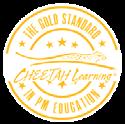
delivery. Their primary focus is delivering a specific outcome or product within a specific timeframe and budget. A project manager who earns the PMP certification is better prepared to lead projects with other PMPs who speak the same professional language.
Most training methods emphasize memorization of terminology; despite those students studying for six months to two years, 80% of them still fail the PMP exam on their first attempt. Students who prepare using accelerated adult learning techniques learn systems thinking so they are able to logically deduce the correct answer without having to memorize. After all, you can’t memorize how to run projects.
More and more companies are looking for PMP credentials in their prospective hires to signify that a person will be able to communicate effectively, collaborate with others to solve problems, and think strategically. —Michelle LaBrosse, PMP, PMI-ACP, RYT, CEO of Cheetah Learning (www.cheetahlearning.com/wp/), an industry leader in Accelerated Exam Prep for the Project Management Professional (PMP)® exam
12 INBUSINESSPHX.COM MAY 2023
LOOKING GOOD
QUICK AND TO THE POINT
Nondisruptive Creation
New growth and opportunity without disrupting and confronting industry players
by W. Chan Kim and Renée Mauborgne
When thinking about innovation, the economic and social impact of the approach is not all that matters. What also matters is an organization’s ability to successfully implement it.

Our concept of nondisruptive creation is about innovating without destroying. It’s the flipside of disruption, where destruction is necessary to create.
While nondisruptive creation may appear more challenging, it has its own business advantages versus disruption, which stem from four sources. While the four sources of advantages may not all apply in every case of nondisruptive creation, the majority will.
The four sources of advantage include:
1. The ability of an industry entrant to bypass big, incumbent players with significant resources and reach in their innovation efforts;
2. The ability of an incumbent to respond to a full-on disruptive threat without confrontation;
3. The responses of internal stakeholders to innovation efforts (nondisruptive creation is emotionally and politically easier for them to get behind); and
4. The responses of external stakeholders to innovation efforts (nondisruptive creation largely sidesteps conflicts with social interest groups and governments).
Let’s dive into one now and explain why it should matter.
AVOIDING DIRECT CONFRONTATIONS WITH ESTABLISHED INCUMBENTS
There’s been a long love affair between Silicon Valley and disruption. Consider Mark Zuckerberg’s original motto for Facebook: “Move fast and break things.”
Not surprisingly, the hope of many startups — and established companies — is to disrupt an existing industry and become the next unicorn. But when a company sets out to disrupt an industry, it should prepare to confront wellentrenched organizations with deep network, financial and marketing resources, which, in the case of startups, will almost certainly tower over those of their own.
Consider the experience of MoviePass, which set out to disrupt the movie theater industry. In 2017, it launched a disruptive strike on the industry with a subscription model that allowed users to watch an unlimited number of movies
per month at the unbelievable price of $9.99 a month — essentially the cost of one adult ticket. Within a year, its subscriber base skyrocketed to approximately 3 million.
Theater owners felt threatened and set out to fight.
AMC, the largest U.S. movie chain, shut its theater doors to MoviePass subscribers, truncating the service’s reach. It then attacked MoviePass’s jugular with its own subscription service, called AMC Stubs A-List, and the other big theater chains, such as Regal and Cinemark, soon followed suit.
With the biggest chains now offering attractive terms that it couldn’t match, such as early ticket purchases, MoviePass ran out of money and was forced to shut down its subscription service in September 2019.
Consider the vastly different experience of Square. While the payment processing industry focused on serving large and medium-sized merchants, self-employed individuals and microbusinesses such as farmers’ market vendors were shut off from accepting credit card payments.
Seeing this untapped opportunity outside the credit card industry, Square set out to seize it. Its solution was a mobile payment system, the Square Reader, made for small businesses, pop-up shops and individuals to accept credit card payments.
Unlike MoviePass, Square’s nondisruptive move created but did not destroy. It caused little if any disruption to the existing payment processing industry. As a result, Square was able to grow quickly into a billion-dollar company without facing any real backlash from established players, who never felt threatened.
By setting aside the preconception that disruption is the way, and thinking in terms of nondisruptive creation, one becomes a sharper observer of nondisruptive opportunities lurking on the horizon that would sidestep rather than take on established players, providing new avenues for economic growth.
If disruption drives your thinking, ask yourself what nondisruptive opportunities might you be missing?
Recent Nondisruptive Innovations
Company Valuation
23andMe: DTC genetic testing that helps understand ancestry & disease without displacing geneticists or hospitals.
$1B+ current valuation
Kickstarter: Public-idea financing without displacing investors or financial institutions. Created ~300K+ jobs, 8K+ companies and $5.3B+ of direct economic impact
Esports: Reimagined gaming as an active and physical in-person sport and is now even an OLYMPIC event without displacing gaming creators or distributors.
While nondisruptive creation may appear more challenging, it has its own business advantages versus disruption, which stem from four sources that include the ability of an industry entrant to bypass big, incumbent players with significant resources and reach in their innovation efforts.
W. Chan Kim and Renée Mauborgne are professors of strategy at INSEAD and co-directors of the INSEAD Blue Ocean Strategy Institute in Fontainebleau, France. Among numerous recognitions, they were named in 2011 the most influential management thinkers in the world by Thinkers50.
Their most recent book is BEYOND DISRUPTION: Innovate and Achieve Growth without Displacing Industries, Companies, or Jobs (Harvard Business Review Press; May 2, 2023).
They are also authors of the global bestseller Blue Ocean Strategy, which has sold more than four million copies and has been recognized as one of the most iconic and impactful strategy books ever written, and Blue Ocean Shift, the New York Times, Wall Street Journal, USA Today and Los Angeles Times bestseller. To date, Blue Ocean Strategy and Blue Ocean Shift teaching materials have been adopted by more than 2,800 universities across the globe.

13 INBUSINESSPHX.COM MAY 2023
METRICS & MEASUREMENTS
Industry worth $1B+ with an estimated 175M+ global fans
Your Patient’s Advocate Helps Individuals Navigate the Healthcare System

Your Patient’s Advocate is a concierge nurse-based patient advocacy business founded in 2018 that supports clients with navigating the healthcare system. Serving where needed, the patient’s care advocate can attend physician appointments, review medications and medical records, set up medication trays and assist with hospitalization and/or care relocation, as well as collaborate with a patient’s current care team to provide optimal care for their unique situation.
“After losing my mother to an unfortunate accident during a hospitalization and dealing with end-of-life challenges, I felt the need to advocate for others who find it difficult to navigate the healthcare system,” says Janie Dalrymple, founder and CEO, who brought to the enterprise her 18-plus years’ experience in nursing, including hospital-based bedside care, home health and the outpatient clinic setting. She has a strong neurology background and was an ALS Clinic Coordinator for Mayo Clinic for several years.
“The most valuable piece of advice I received was to grow the business based on our belief that everyone should be supported in their healthcare journey,” Dalrymple shares. “It has been the basis of the service we provide, and so many have benefited from the support we provide. My goal is to treat every client as if they were part of my family, and I strive to find team members who give the same high standard of care.”
In addition to a full staff of nurse-based advocates, Your Patient’s Advocate includes a respiratory therapist,
social worker and physical therapy assistant to assist with providing complete guidance for nearly all healthcare needs. And Dalrymple recently hired a director of client services to help her meet one of the biggest challenges she’s faced in launching her company. Explains Dalrymple, “Her main role is to reach out to independent and assisted-living facilities to get the word out about how we can assist their residents.”
—RaeAnne Marsh
Your Patient’s Advocate yourpatientsadvocate.com
The Journey Disrupts with Diversity in Venture Funding
The Journey is a mission-driven venture studio building disruptive healthcare companies in partnership with the next generation of diverse founders. Unlike an accelerator or incubator, a venture studio doesn’t fund existing startups but rather is a company that creates multiple startups in-house and then partners with entrepreneurs who take over to launch and scale them. “Our mission is to close the racial and gender opportunity gap by empowering diverse founders to pursue entrepreneurship while providing resources and support to increase their odds of success,” says Mark Moeremans, managing director of the nonprofit that launched in January of this year.
“There is a massive gender and racial opportunity gap in the venture world that continues to go unresolved,” Moeremans explains. “Entrepreneurship is meant to be a merit-based pathway for success in this country, yet less than 2% of all venture funding goes toward women or minorities. We wanted to launch a studio that removed the systemic barriers that prevent talented diverse leaders from pursuing entrepreneurship, while providing the tools and support to improve their odds of success.”
After extensively researching what programs and resources already existed, so as to not duplicate or take away from the efforts of others, The Journey founders combined the most impactful pieces of different models (a traditional venture studio, leadership development and business acumen training) to create something new and differentiated. That was the first challenge. The second stemmed from succeeding at the first. “Any time you create something new, you must spend time educating the community about what exactly you have to offer, and so we have spent a lot of time working with partners to establish community support and understanding,” Moeremans says.
Citing the African Proverb, “If you want to go fast, go alone. If you want to go far, go together,” Moeremans says, “We are lucky that Phoenix is home to a thriving healthcare and bio-science hub, a city with a maturing investor community and a network of entrepreneurial support organizations and service providers. We know we want to ‘go far’ as an organization and we are ready and excited to ‘go together’ with like-minded individuals and organizations across the state.” —RaeAnne

The Journey Venture Studio thejourneyventures.com
 Marsh
Marsh
14 INBUSINESSPHX.COM MAY 2023 Photo courtesy of Your Patient’s Advocate MAGAZINE Special Section: 11 Top Business Organizations You Must Know BRICK-AND-MORTAR and ‘Flatlining’ Strategies Dangers of ‘Quiet Promotion’ This Month’s Guest Editor Kate DowntownBorders Tempe Authority ISSUE Global Chamber INBUSINESSPHX.COM Changing Requirements Data Privacy Why BusinessesBrick-and-Mortar AreBooming Retail on Top DON’T MISS OUT! Get a year of In Business Magazine Subscribe now at inbusinessphx.com Women and minority founders face unique obstacles that prevent them from succeeding in the venture world. The proof is in the data with less than 2% of venture capital funding going to these groups. The Journey’s “founder-in-residence” program is designed to account for cultural sensitivities and challenges unique to underrepresented entrepreneurs.
ENTREPRENEURS & INNOVATORS
Novus Innovation Corridor:
A model for modern urban cities and the 21st-century university
How does a major research university make the best use of its last 355 acres adjacent to its main campus in Tempe?
If you’re Arizona State University, you create a development that is a model for modern urban cities.
Novus Innovation Corridor is designed to be distinctly different, with a unique innovation ecosystem that aligns education with employment. As part of this vision, Novus will offer access to knowledge, people and ideas; empower businesses of all sizes to grow and scale at an impeccable speed; and attract new companies looking to locate in an intellectual environment.
The results: diverse jobs; a mix of office, retail, residential, hospitality and entertainment venues; and new private investment.
The model will also generate much-needed revenues for world-class athletics facilities. Funds generated from the district will cover the cost of renovations of existing sports facilities and finance new ones.
It’s a big undertaking. But after more than a decade of planning, ASU, in partnership with master development partner Catellus Development Corporation and City of Tempe, is bringing this vision to life.

Novus Innovation Corridor is completing Phase III of a 20-year build-out that will feature 4.5 million square feet of prime Class A office space; 4,100 residences; 1,000-plus hotel rooms; and 275,000 square feet of retail stores, restaurants and entertainment options in a pedestrian-friendly neighborhood. There will be outdoor gathering places for residents and visitors, and numerous activities and events.
The six-story 777 Tower, with 160,907 square feet of office space and 7,760 square feet of retail space, is a U.S. hub of Infosys, which provides business consulting, information technology and outsourcing services.
The new ASU research building — the Rob & Melani Walton Center for Planetary Health — underscores the university’s commitment to science.
Tempe also has new housing options, thanks to the opening of The Piedmont, a six-story, 318-unit luxury apartment community. Transwestern Development Corporation is working on two additional residential communities.
Beyond the tangible signs of progress, Novus is realizing its goal of becoming a sustainable development. The U.S. Green Building Council ranked Novus among the top 10 U.S. best-scoring LEED-ND projects — designed to combat urban sprawl and create sustainable and connected communities — of all time. Novus’s 777 Tower also achieved LEED Gold-level USBC certification, and the Rob & Melani Center for Planetary Health is LEED Platinum-certified. And ASU and Catellus are setting the standard for green living by making Novus the epicenter for transportation solutions, resource and utility usage, and responsible waste management.
Then there is the economic impact. ASU’s Seidman Research Institute projects Novus will generate $1.86 billion in annual economic impact and add 34,000 jobs by 2035 through office, hotel, multifamily and retail operations. The economy will also benefit from Novus’s more than 20,000 temporary construction jobs.
True to its vision, this trailblazing development will also drive employment in cutting-edge industries and bring lifelong learning, commercial, real estate, living, entertainment and research together in one location to develop the 21st-century university.
—Charley Freericks, senior vice president of Catellus Development Corp. (catellus.com)
[See more images of Novus Innovation Corridor in the CRE Top Projects section, on page 56.]
GET REAL Listening
Facilitated Successful Logistics Center Construction
Phoenix-based Stevens-Leinweber Construction recently completed the custom build-out of 160,000 square feet at Phoenix Logistics Center Two, designed to meet the manufacturing and distribution needs of new tenant Georgia-Pacific LLC and its HP PageWide T1190 Press, the world’s largest high-volume digital pre-print solution for corrugated packing.
“This project was a great exercise in listening, learning, planning and executing on precise requirements, with a result that brings something very unique to the Valley,” said Stevens-Leinweber Construction Vice President Erik Powell. “Those requirements influenced everything from our earliest foundation plans to the final assembly of the T1190 press, which came in numerous cargo boxes shipped from overseas, trucked to the PLC Two building, and then unboxed and assembled piece by piece by experts brought over from Germany for this specific task.”
To support the T1190, SLC constructed a specialized foundation requiring 163 piers, each drilled 15 feet deep, to help support an 18-inch-thick mat concrete foundation with heavy rebar reinforcement. The construction team also brought in 7200 amps of dedicated power specifically for the Georgia-Pacific tenant improvement, as well as temporary power to allow Georgia-Pacific, one of the nation’s leading packaging providers, to test its equipment while waiting for long-lead-time electrical gear. A heavyduty HVAC package was installed during the build-out to help manage the higher level of heat and air pressure generated from the printer.
SLC completed the shell building and tenant improvement for Georgia-Pacific. Ware Malcomb was the building’s project architect. Anthony Lydon, Marc Hertzberg, Riley Gilbert and John Lydon of JLL are the building’s exclusive leasing brokers.
Totaling 481,600 square feet, PLC Two is the second building within Merit Partners’ Phoenix Logistics Center, a state-of-the-art warehouse, distribution and manufacturing campus located at the southeast corner of 91st Avenue and Buckeye Road in Phoenix, within the I-10 Corridor. —Mike Hunter

meritpartnersinc.com
stevensleinweber.com
15 INBUSINESSPHX.COM MAY 2023
Photo courtesy of Novus Innovation Corridor PROPERTY, GROWTH AND LOCATION
According to Com mercialCafé’s newest vacant land study, Phoenix ranks 3rd for its vacant land available, with a total of 53,022 acres spread across 15,897 parcels, and the average parcel size for the vacant land currently available is 3.34 acres. commercialcafe.com/blog/us-vacant-land-study
Camelback Corridor Renovation to Redefine the Modern Workplace
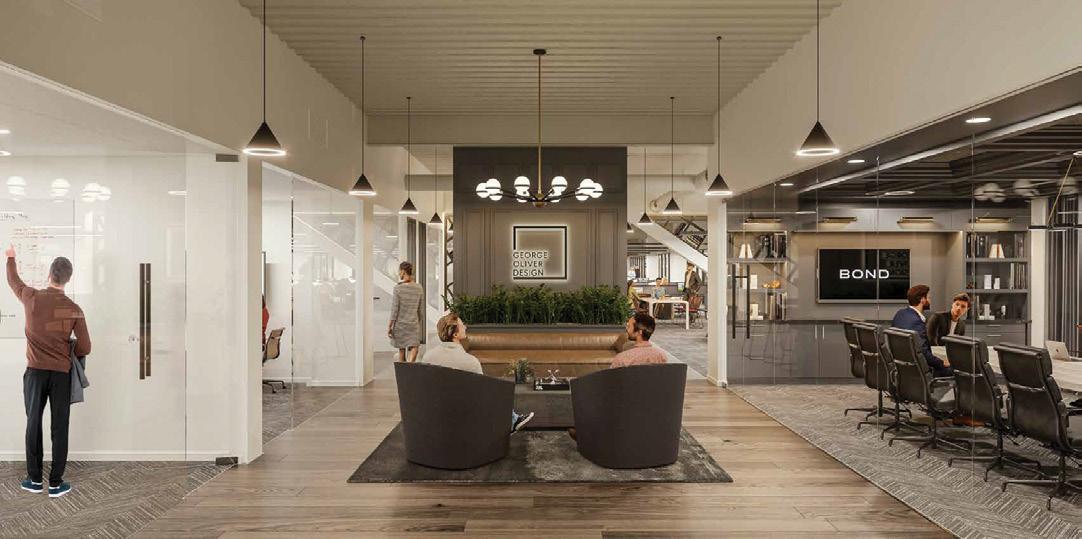
Phoenix-based developer George Oliver, known for its cutting-edge office redevelopments, has unveiled plans for Bond, a $52 million renovation that will transform the landmark Biltmore Commerce Center into a hospitalityinspired office experience where thoughtfully crafted amenities and modern design bring teams together in an unparalleled workplace at the heart of the desirable Camelback Corridor.
“Employers committing to an in-office work environment are putting workplace culture front and center. Bond was designed with this in mind. Its name signifies a reconnection of the lost bond between employee and employer,” says George Oliver founder and managing partner Curt Kremer.
Located at 3200 E. Camelback Rd., Bond totals 287,000 square feet in three stories, with office space bordering a corresponding three-story central atrium. Through its renovation, George Oliver will elevate this space
with one of the market’s most extensive amenity packages that starts with a conference center, co-working space, a full-service coffee, cocktail and food service bar, an extensive fitness center and a speakeasy cocktail bar — curated to create an environment to work, dine and relax.

Shell renovations at Bond begin this month. The first suites at Bond are scheduled to deliver in the fourth quarter of 2023. Shell completion is scheduled for the third quarter of 2024. George Oliver Design led the design and architecture for Bond. RSG Builders is the general contractor. CBRE is the onsite property management team. Ryan Timpani and Brett Thompson of JLL are the exclusive leasing brokers.
“Heavily amenitized office space has never been in greater demand, even compared to past ‘bull markets.’ Bond represents the type of trophy office that every user profile — from Fortune 500s down to start-ups — is gravitating toward,” Timpani says. —Mike Hunter
Bond bondphoenix.com
George Oliver LLC georgeoliver.com
Repurposed CRE Elevates Design for Health Clinic
A unique project transformation was recently completed on the NOAH (Neighborhood Outreach Access to Health) Cholla Health Center, located at 8705 E. McDowell Rd. in Scottsdale. Ware Malcomb, an award-winning international design firm, provided interior architecture and design services for the approximately 32,000-square-foot medical office facility. General contracting services for the project were provided by Integrity Building Corp.
What was a car dealership is now a two-story healthcare facility that includes 24 medical exam rooms, 6 dental care and operatory spaces, 20 counseling and psychiatric offices, a group therapy area, a play therapy room, psychiatric triage room, on-site lab services, a multi-purpose room and offices for Community Resources support.
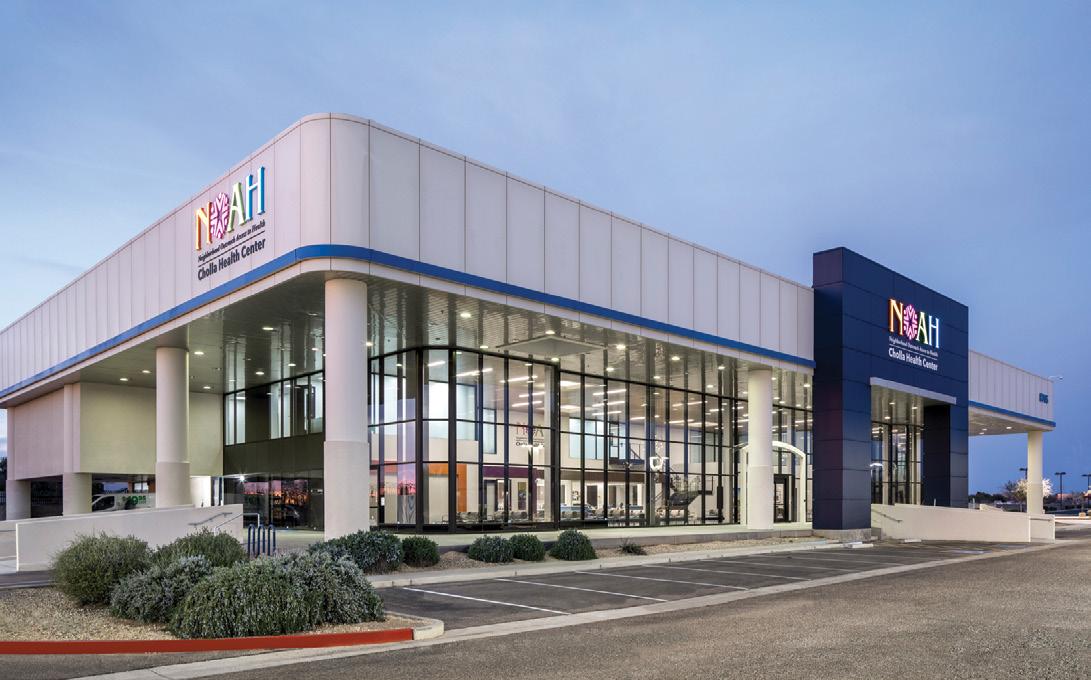
While carefully designing all the required programming in the space for this new clinic, Ware Malcomb worked closely with NOAH to capitalize on the building’s high freeway visibility and achieve a large, open lobby space with an elevated design. To accommodate the new lobby design, the Ware Malcomb team expanded the second level by 1,071 square feet. The additions to the second level required structural engineering for the added floor area, as well as a new feature staircase within the lobby.
The new clinic replaces three of NOAH’s former health center locations and
will serve as the organization’s largest health center in terms of floor area. The facility has the capacity to serve more than 16,000 patients every year, 25% more than the three former locations combined. —Mike Hunter
Integrity Building Corp. ibcaz.com
Ware Malcomb waremalcomb.com
In Phoenix, 8% of the total buildings that include co-working spaces are LEED certified; the city’s three LEED buildings to include co-working make for more than half of the state’s total number (5), which help place Arizona in 12th place in the ranking by CommercialCafé. coworkingcafe.com/blog/us-cities-most-green-buildings-with-coworking-spaces
16 INBUSINESSPHX.COM
2023 PROPERTY, GROWTH AND LOCATION
MAY
Photos courtesy of George Oliver (top two), Kyle Zirkus Photography (bottom)
Traditional real estate investment approaches are being challenged. Investors need a fresh perspective and a focus on flexible, sustainable, technology-driven assets to build resilience and shape the future of real estate.

We partner with investors to help them reposition, diversify and repurpose their assets and portfolios to enhance performance and drive returns.
Let’s shape the future of real estate.
Is it time for a new perspective?
© 2022 Jones Lang LaSalle IP, Inc. All rights reserved.
PHOENIX REALTORS – THE HOME OF OPPORTUNITY
Delivering value with every membership is Phoenix REALTORS’ mantra. Last year, members:
• Took 1,500+ continuing education classes at no cost to them.
• Accessed six different in-depth, interactive market statistics tools for free.
• Saved more than 1,800 miles through the Phoenix InFlight program, which provides members complimentary delivery of lockboxes, sign riders and other store purchases.
• Spent 300+ hours in complimentary executive suites and 200 hours in the association’s 12-person conference room.
• Saved more than $10,000 in the REALTOR® Store, the lowest-cost option in the Valley, on resources they need.
Andy Fegley Steers Reinvention of Valley Real Estate Association
Evolving with the times, Phoenix REALTORS® becomes benchmark among industry associations
by Mary Little
Associations are often slow to embrace change, but it’s crucial for them to adapt and grow to thrive. In fact, many organizations may get stuck in a rut when they become complacent and fail to adapt to changing market conditions, resulting in stagnant growth and a lack of innovation.
These are the truths that have guided Andy Fegley, chief executive officer of Phoenix REALTORS®, as he has transformed staid business models into thriving, best-in-class operations.

Today, Phoenix REALTORS® is a progressive, memberfocused organization and the leading expert in the industry, supporting more than 11,000 real estate sales professionals in the nation’s fifth-largest city. It is a benchmark among REALTOR® associations across the country, offering unique member services, prompt support and resources, and the timeliest industry information to its members.
But it wasn’t always this way.
In 2019, Fegley inherited a vastly different organization that mirrored other REALTOR associations around the nation. With fewer than 9,000 members at the time, it wasn’t the largest, the most notable or the most resource-heavy organization.
Drawing from his background as an agent of change, including more than 14 years spent advancing the missions of various trade associations and clients, Fegley saw the need to transform Phoenix REALTORS into a modern association that would set a standard for others to follow.
“We identified three primary areas that would help us foster a culture of outstanding service and adaptability, ensuring the ongoing success of both our members and our association,” says Fegley.
PRIORITIZING MEMBERS
The well-known quote, “Ask not what your country can do for you; ask what you can do for your country,” served as Fegley’s guiding principle as he cobbled together Phoenix REALTORS’ reinvention.
According to Fegley, though it’s a two-way street, organizations too often get trapped thinking about how they can leverage their members, whether by sourcing their expertise or tapping into their resources, instead of looking at what new offerings they can bring to the table.
“We shifted our thinking to focus solely on helping our members prosper, which started with our efforts dedicated to providing exceptional service,” says Fegley. “This included investing in technology and actively seeking member feedback, which revealed to us how we could be a better and more effective resource to them.”
Listening to what members needed and wanted, Phoenix
REALTORS started offering value-based resources, including free education on current issues, no-cost workspaces, an in-house member café and member discounts on frequently used resources.
“With the investments we’ve made, our members have provided feedback that reinforces the fact we have created a supportive organization that puts them first,” says Fegley.
STRIVING TO BECOME THE LEADING AUTHORITY ON THE VALLEY’S REAL ESTATE SCENE
Fegley pointed out that outreach to members within the REALTOR community revealed there wasn’t much effort to introduce new ideas or thoughtful resources that have kept up with the times.
“With this in mind, we doubled down on our commitment to staying informed about the most relevant issues and topics affecting members throughout the Valley,” says Fegley. “We invested in numerous resources to equip REALTORS with the tools they need for success. This includes providing a central hub for up-to-date research, statistics and data, as well as insights on trends, fostering collaboration with industry professionals and external partners.”
ENSURING RESPONSIBLE MANAGEMENT OF MEMBER RESOURCES
Doing more with less has become commonplace, whether in the nonprofit or business world. For associations, the purse strings are even tighter as they are run solely on member dues, making it challenging to provide quality services when there are so many demands on the organization.
“We are accountable to our members. And as such, fulfilling the responsibility of providing the highest standard of service to our members is of utmost importance,” says Fegley. “To be the most responsible stewards of member resources, we streamlined operations to increase efficiency, divested an underutilized building and reinvested those funds in resources that directly benefit members, and concentrated on delivering the essential resources REALTORS require.”
And in growing the association by more than 25% in four years, Fegley says he is positioning the organization for even more growth.
“Phoenix REALTORS is a trailblazer and is setting the bar for excellence in the industry,” says Fegley. “I believe that our commitment to innovation can inspire other associations to adopt better ways of doing business, fueling industry-wide success and growth.”
Phoenix REALTORS® phoenixrealtors.com
There are more than 40,000 active REALTORS in the Valley and surrounding areas. In 2022, they facilitated nearly 110,000 new listings and 81,084 sales in the area. Their average sale price was $580,470, which was up 14.1% from 2021.
18 INBUSINESSPHX.COM MAY 2023
MINDING THEIR BUSINESS

WE EQUIP ARIZONANS WITH EDUCATIONS AND TRAININGS THAT LIFT PEOPLE FROM A MINIMUM WAGE TO A FAMILY-SUSTAINABLE WAGE. GOODWILL IS BUILDING PATHWAYS OUT OF POVERTY FOR ARIZONANS IN NEED Goodwill of Central and Northern Arizona is a 501(c)(3) non-profit organization dedicated to ending poverty through the power of work. To learn more, please visit: MoreThanAStore.com
Urgent Care Service for Skin Care
Adair Family Clinic and MedSpa, a full-service healthcare clinic with multi-specialties focusing on skincare and wellness, recently launched a new urgent care service for skin care needs called Triage

My Skin.
This new service comes at a time when dermatology clinics are swamped seeing patients with weeks sometimes months before the next available appointment, even for patients referred by primary care providers for issues as serious as skin cancer, and medical clinics are swamped seeing patients with chronic conditions like diabetes and heart disease.
Triage My Skin allows patients to arrive at the clinic at any time during business hours and request a skincare triage, similar to an urgent care process.
The medical assistant or nurse will greet the patient and escort them to the triage area for examination and begin the triage assessment. Based on the concern, the examination will continue with an evaluation by an experienced esthetician for skin analysis. A nurse practitioner, PA, DO or MD will complete the evaluation of the skin concern with treatment plan, recommendations and prescription medication if needed.
Patients can come in for a variety of skincare issues including Acne, Melasma, dermatitis, allergic reaction, skin irritations, Rosacea, hyperpigmentation, psoriasis, skin swelling, medication related skin disruption, diabetic hyperpigmentation, liver spots, wounds, keloids, Lupus, scarring, and skincare routine problems.
Adair Family Clinic and MedSpa founder and medical director Kris Adair, MSN, RN, FNP-BC, who holds a master’s degree in nursing education and a post-master’s degree as a Family Nurse Practitioner, has more than 12 years’ experience as a registered nurse in internal medicine, wound and skin care, operating room, PACU, cardiology, progressive care and telemetry. —Mike Hunter adairclinic.com
Start the Mental Health Conversation
Stress and burnout continue to be critical issues in the workplace. And, while great inroads have been made in overcoming any stigma attached to the topic, there is still some hesitation in bringing it into the open.
Here are five ways business leaders can start the conversation:
1. Create an environment of support and open communication Companies that don’t prioritize mental health create cultures that are stressful and unhealthy. It is important to create a culture that is respectful of others and allows for open communication.
2. Lead by example and initiate the conversation. Team members will follow the example that is set in the workspace. Leaders who recognize the value of mental health days and take them themselves will demonstrate to their teams that mental health is not just about hanging up a picture in the breakroom, but something that is valued.
3. Explore and schedule mental health workshops Learning with one’s team is a great way to create a culture that is team-oriented and supportive. It also demonstrates the importance of mental health and wellness. Taking time out

of the business day to participate in a mental health workshop can be an effective way to do both.
4. Offer resources to employees and incorporate them into benefits packages
Plenty of companies offer fitness or education reimbursement, but they should also offer mental health reimbursement. If resources were readily available and viable options, they’d be taken by more people.
5. Create a culture that supports people
Ultimately, it’s important to create a work culture that supports and lifts up its employees. This is done on a macro level, with things like benefits packages, workshops and flexible work schedules. It is also done on a micro level. How leaders speak to their team members, how they lead their teams together and how they encourage open communication is key to creating a culture that supports its people. —Jonathan Shroyer, chief CX innovation officer at Arise Virtual Solutions (www.arise.com), who has two decades of experience building up companies and leaders and was named by CIO Journal, a publication of The Wall Street Journal, among its “Top CX Professionals of 2022”
20 INBUSINESSPHX.COM MAY 2023 May is Mental Health Awareness Month.
WELL WELL YOUR BENEFIT IN BUSINESS
WELL
IS WHAT GIVES US PURPOSE HONOR








Honor is what motivates our team of dedicated healthcare professionals. Through passion and purpose, we come together to ensure every patient is provided with the best possible care. honorhealth.com










AI and Bias in the Insurance Industry
Artificial intelligence is a tremendous asset to companies that use predictive modeling and have automated tasks, but AI still has a ways to go to completely eliminate bias. Just like humans can show bias, so can AI, because it’s trained on humangenerated data. Leading insurance tech provider Zelros knows this all too well and is leading the way when it comes to responsible and ethical use of AI.
When human data is involved in teaching AI systems, unintentional bias happens. One of the most noticeable is gender bias, occurring when the AI system does not behave the same way for a man or a woman (husband or wife), even when the only variable presented to the system is gender. This can lead to individuals who should be in the same risk category being offered unequal policy advice.
Making an AI system goes much deeper than having it just be self-sustainable. It needs to be open for self-criticism and ongoing improvement through the design itself. Analyzing different metrics at various subgroup levels within a specific model feature is one key to identifying and keeping biases from occurring before going to market. With any AI, having it avoid falling for Simpson paradoxes through these methods ensures that the personal data isn’t used against the client/consumer it is actually supposed to be benefiting.
Companies should recognize that biases may be hidden in unexpected places. There can be a bias in the training data (hence in the associated trained model), or in the data later at inference/ prediction time — or even both. One of the things Zelros encourages is companies use open-source strategy to be more open and transparent in their AI initiatives. Zelros does this, as do other companies, including Google and IBM. —Christophe Bourguignat, founder of Zelros (www.zelros.com), a technology company offering the first-ever AI software dedicated to insurance distribution
Prep Proactively for Emerging AI
Artificial intelligence is the development of computer systems able to perform tasks normally requiring human interaction and intelligence. This can include visual perception, speech recognition, decision-making, translation between different languages, and more. AI tools can help business managers avoid biases in decisions. AI is continually evolving and advancing. Today, businesses are seeing wide coverage and noise surrounding the topic. It is often tricky to navigate its success within the business world.
Last year, the global AI market was valued at more than $140 billion and has been projected to continue to accelerate in growth over the next decade. With this, customer satisfaction is expected to grow significantly this year due to the adoption of AI tools across business operations. A great example of the successful implementation of AI applications can be seen across small to medium-sized businesses. AI-powered automation can provide smaller companies with the freedom to not only manage but also accelerate their business growth and, in turn, leverage cost-saving benefits at the same time.
HOW CAN A BUSINESS PROACTIVELY PREPARE TO IMPLEMENT AI?
Customer experience and sales support services: Businesses are leveraging AI to introduce remote or virtual call centers and receptionists to help assist with incoming call loads. We are seeing virtual agents replacing human agents in some instances along the customer and sales journey.
Speech recognition: Speech recognition is the capability that enables a program to process human speech into a written format. Speech recognition is being more widely offered through VoIP (Voice over Internet Protocol) phone telecommunication features. The benefits of speech recognition lie around how it can be a key driver of revenue growth and efficiency while streamlining and reducing traditional or legacy business processes.
AI for targeted marketing: More businesses appear to be utilizing the advancements in AI to

supercharge their online marketing efforts. Online search providers, retailers and other businesses with an online presence use intelligent systems to understand users, their buying cycles and behavior patterns. AI marketing applications assist businesses in delivering targeted marketing in the real world.


Benefits: AI applications are helping make better, faster decisions; AI tools are empowering the customer services offer; AI applications are improving sales and marketing ROI; and AIempowered tools are boosting team productivity. What’s on the Horizon for AI and How Best to Leverage It?
Some data engineers talk of Artificial Intelligence Consciousness, with self-aware machines following a path that mirrors the evolution of humans. The outlook for AI is both impressive and can be overwhelming, but it is important to stay in check with reality. AI tools continue to require human governance to maintain, mentor and monitor the data inputs. It is vital that businesses do not become disillusioned by reality, in that there will always be a need for human-centered thinking within any organization.
Fundamentally AI tools can eliminate unnecessary bottlenecks and streamline operations. Machine learning automation can be programmed to deliver repeatable processes, removing the need for a dedicated team. AI can even help facilitate natural sales conversations, answer customer service inquiries and track customer behavior data. Essentially, businesses will find ways to leverage AI to deliver a specific automated process and shortcut monotonous, menial tasks to avoid attention and productivity drifting. It has been proven that cloud-based virtual technologies like VoIP, paired with AI automation tools, are redefining what it means to do business in the modern world. It will be exciting to witness ‘what’s next?’ for AI in the years to come. —Dmitry Tokar, co-founder of Zadarma (zadarma.com/en/), an industry-leading VOIP platform that provides AI-based speech analytics and transcription services
Companies that want to use AI responsibly can collaborate with organizations like Isahit (www.isahit.com), which is dedicated to helping other organizations become competent in their use and implementation of responsible and ethical AI.
22 INBUSINESSPHX.COM MAY 2023
TECH NOTES INNOVATIONS FOR BUSINESS
Making energy-efficient upgrades with SRP Business Solutions pays off. We offer a range of rebates on things like new HVAC systems and refrigeration to LED lighting and EV fleet transformations. If it saves energy, chances are SRP has a rebate for it. See

EFFICIENT UPGRADES WITH SRP BUSINESS SOLUTIONS.
SAVE ON
a list of available
at
rebates
savewithsrpbiz.com
Beyond Just




T
FROM PURPOSE TO BOTTOM LINE
Using the familiar term “diversity, equity and inclusion,” Duffy Group’s focus on DEI reaffirms the way the company does business, explains Kathleen Duffy, president and CEO of the employment agency. “We use a model called Recruitment Research that enables our recruiters to take a deep dive into our clients’ businesses and thoroughly understand desired candidates and the competitive dive landscape. Throughout the search process, we scour our recruiting practices for unconscious biases. We also help clients examine job descriptions for biases and seek ways to include diverse candidates in each search.”
This focus, she reports, has helped Duffy Group earn a reputation as a go-to source for recruiting diverse candidates. And she cites recent national research that 43% of companies with diverse management report higher profits and 73% of companies with gender-equality practices have higher profits and productivity. “This same national research revealed that 78% of employees believe DEI in the workplace offers a competitive advantage and 35% of the U.S. workforce are Millennials who, as a generation, are driving DEI and demanding proof that it exists in their workplaces,” she adds. And she points to a more personal bottom-line impact as well: “This research plays out in our recruiting efforts and at our own company, with 89% of our employees reporting a positive view of Duffy Group’s approach to DEI, according to finding from a recent internal survey,” she says.
Liz Shipley, Arizona public affairs director for Intel, shares what the program looks like at that tech giant. “At Intel, we highlight our commitment to diversity, equity and inclusion through open conversations and using the terms directly,” she says, noting that transparency to Intel’s commitment to DEI further allows the employer to promote its mission and goals clearly to all employees. “Intel’s commitment, as demonstrated through our expansive goals to specific community initiatives, creates value for Intel, our stakeholders and the Chandler community.”
Affirming that Intel understands that today’s greatest challenges require a shared commitment to a plan and meaningful action to advance diversity, equity and inclusion, Shipley says, “The bottom line is that diversity and inclusion are instrumental in driving innovation and delivering a diverse workforce for a strong business growth.”
“Terros Health uses the term ‘inclusion, equity and diversity,’” says Stephanie Watson, chief people and culture officer, whose years of working in this area have shown her that an inclusive environment is the best way to identify and get buy-in to issues of inequity and how they need to be addressed – and then, once equity is better established, a company can foster diversity. “Terros Health references these issues in the order we feel they need to be established to yield success,” she says. And she expands on the terminology: “When it comes to our goal for the company, we leverage the terms ‘connection’ and ‘belonging.’ We want our patients, employees and partners to feel connected to the organization and each other. Most important, we want to foster an environment where everyone feels they belong and that they are valued and respected.”
For Terros Health, the bottom line is its support of diverse communities. “The retention of our patients is key to building strong and healthy communities. By creating an environment where patients feel welcome and a sense of belonging, we can drive positive outcomes expected for grantees and payors. This helps us maintain funding for our staff, deliver the best possible care to our patients and support communities across Arizona,” Watson says.
StrataTech Education Group is “dedicated to fostering a culture of diversity, equity, inclusion and belonging,” says CEO Mary Kelly, noting DEIB starts in the classroom, where it is integrated into the training the company provides and its importance emphasized from the very beginning.

“Through our Corporate Social Responsibility partnerships, we create more diverse and inclusive opportunities and bring more underrepresented communities into the skilled trades,” Kelly adds. “Our efforts to promote DEIB in the skilled trades industry have helped to create more equitable opportunities and improved the quality of our training and the skilled trades as a whole.” In fact, these collaborations have enabled StrataTech to help more than 370 students from underserved areas pursue a promising career.
Kelly points to multiple ways StrataTech’s DEIB program is positively impacting the company’s bottom line. “We have seen an increase in student population due to our broader outreach and Gen Z’s commitment to organizations with DE&I initiatives.” She notes her company has gained diverse perspectives that have resulted in EBITDA-positive contributions. “Moreover, we have been able to open up new B2B client opportunities through OcuWeld, our virtual reality welding training program, allowing us to upskill employees remotely.” All of this, she reports, has also increased employee engagement which has led to improved productivity.
Sundt Construction refers to its program as DEI, but “we certainly include belonging when we are discussing these issues,” says Nicole N. Calamaio, chief human resources officer. “Our program relies on a holistic framework with the following components: leadership alignment, diversity committee, pipeline diversity, education and training, community connections, and measurement,” she explains, noting that, as a general contractor employing more than 2,000 people, Sundt is proud to be a 100% employee-owned and majority-minority company.
Based on data and measurements collected, Calamaio says, “We believe organizations that integrate DEI into their culture not only become more diverse, but more innovative. Innovation and diverse thinking help to drive business results, which benefits every one of our employee-owners.”
Sundt also takes its belief in the value of DEI beyond its own workforce, placing importance on providing opportunities and support to small, local, disadvantaged, and diverse business enterprises (XBEs). “In turn, the skilled work of our XBE community is often the cornerstone of our projects’
26 INBUSINESSPHX.COM MAY 2023
success. We’re proud to work with XBE trade partners through each phase of our projects, contributing to their business growth and prosperity,” says Calamaio.
Making the point that, by partnering with XBE businesses for its projects, Sundt can help bring greater prosperity to the larger business community, Calamaio also notes, “Providing internal and external opportunities makes our DEI program more robust.”
Creating diverse, equitable and inclusive environments where all feel they belong is the focus at University of Phoenix, according to Julie Fink, VP of human resources. “Our ever-evolving efforts prioritize the needs of our diverse students — as well as our faculty and staff,” she says. “Whether through our active employee resource groups, our community engagement or the regular review of our curriculum for bias and inclusive content, we are continually evolving to ensure our University community members experience an environment where they belong and thrive.”
Fink emphasizes the fact that faculty, students and staff choose to come to University of Phoenix. “Employees and, for the most part, students, can go anywhere,” she says. Answering her own question, “Why do they want to come here?” she explains, “Because they feel like they belong here.” More than 50% of students identify as minority, seven in ten are women; more than 55% of the faculty are women, with 40% identifying as a race other than White; and, on the staff side, more than 60% are female and 57% identify as a race other than White.
“Almost 50 years ago, University of Phoenix began serving those students who were underserved in what was the traditional university system,” Fink says, noting it is a role the university continues to embrace. Observing, “It has been said that DEIB is the right thing to do,” she notes that, at University of Phoenix, “it’s simply what we do. It’s who we are. It’s in our DNA — and every employee and faculty member is our chief diversity officer.”
“A ROSE BY ANY OTHER NAME …”
Of course, the purpose matters more than the label, and in some organizations, the aspiration is packaged under a different heading.
“We use REI — Race, Equity and Inclusion,” says Nate Rhoton, CEO of onen-ten, a nonprofit organization that serves LGBTQ youth and young adults. “We have and continue to look for new ways to incorporate REI into the
fabric of all we do. The work to do so is a constant and cannot be considered a ‘one and done’ strategy.”
Last year, one-n-ten added a director of people and culture to its leadership team with the purpose of prioritizing proven experience with implementing DEI/REI strategies in the workplace and building inclusive teams. Sharing, “The investment has proven to be invaluable to our work and staff culture,” Rhoton reports that keeping REI as an inherent value in the organization has helped with attracting and keeping talent — with an incredibly low 3% turnover in full-time employees over the last year. “Employees report they feel more supported, even when having sometimes necessary and difficult conversations,” he says.
At Goodmans Interior Structures, president Adam Goodman eschews labels completely. “At Goodmans, we’re not trying to hit a quota, placate investors or impress customers. We’re simply trying to do right by our employees, so we don’t need to wrap our efforts around a branded term,” he explains.
The company’s efforts are directed to a demonstrable outcome. “Simply put, we are focused on removing unconscious bias from our hiring and promotion decisions,” Goodman says. The starting point was evaluating the company’s practices and finding a form of unconscious bias called “occupational sorting” that routes people to different career paths based on their race or gender (“Think, ‘boys are doctors, girls are nurses,’ but specific to an industry and/or company,” Goodman explains). To correct this imbalance, Goodmans began implementing objective tools and insights into all talent related decisions that take place at the company — stretching across the entirety of the talent life cycle: recruitment, hiring, onboarding, career development, team dynamics, promotions and succession planning. Says Goodman, “With objective data on an individual’s communication styles, drivers and strengths, we can plot their profile against a particular role’s benchmark profile of high performers.”
Reporting that this “indirectly helps our bottom line by improving our talent attraction and retention,” Goodman characterizes the effort as being, fundamentally, about fairness to the employees. “That kind of commitment is appreciated by both our employees and prospective employees,” he says. “More to the point, this practice is congruent with our corporate value to make our employees a priority in everything we do. This improves the culture to the extent the company does what it says we will do, and it signals to employees that they can trust leadership.”

27 INBUSINESSPHX.COM MAY 2023
“Through our Corporate Social Responsibility partnerships, we create more diverse and inclusive opportunities and bring more underrepresented communities into the skilled trades.”
— Mary Kelly, CEO StrataTech Education Group
LIVING UP TO THE PROMISE
Diversity programs are as diverse as the organizations that execute them, built to suit each organization’s individual structure and mission. But a common element in all effective programs is measurement, to ensure the program actually achieves its intended goal.

So, what are their achievements — and what are their benchmarks?
DUFFY GROUP
“Our company has always made DEI a priority, but during the past two years, we put in place additional policies and practices to build a culture of acceptance so that all stakeholders — from employees to clients and business partners — feel comfortable and welcome,” Duffy says.
The company invested in training so team members could become certified diversity recruiters. Currently, its nine certified DEI recruiters are implementing the training companywide.
In addition to the “Recruitment Research” model described earlier that Duffy Group uses with its clients, the company has stepped up its DEI efforts internally by forming a DEI Committee to address relevant issues and seize opportunities, with a particular focus on inclusiveness. From this has come a variety of actions, ranging from weekly “huddle” meetings with rank-andfile employees to ensure their voices are heard and concerns are addressed to facilitated assessments and team building based on the Enneagram Personality System.
The company also added two paid flex days to the vacation calendar to support employees celebrating federal and religious holidays such as Passover, MLK Jr. Day and Juneteenth.
To measure engagement and outcomes within her company, Duffy says the company fields surveys with its entire workforce and, each quarter, hosts an interactive session on DEI topics with an outside consultant. As to her clients, she says, “We find that our clients are using focus groups and listening sessions to get ideas, measure outcomes on DEI practices and address DEI issues of the day.”
INTEL
“Intel’s commitment to diversity and inclusion is embedded in our purpose to create world-changing technology that improves the life of every person in Chandler and across the globe,” Shipley says, and notes, “It starts with investing in our people and their professional development.”
One of the ways Intel measures engagement is through an employee inclusion survey. Serving as an opportunity for employees to confidentially share feedback about their inclusion experiences, the survey provides important data used to help Intel develop or tailor programs, track progress and identify gaps and opportunities to meet the goals it laid out for itself in its 2030 “RISE” for inclusivity as well as advancing social, ecological and corporate purpose. “Throughout the implementation of this survey, Intel has been able to adapt to and meet the needs of our employees by identifying new approaches to DEI,” Shipley says. “Outcomes are reported consistently as a tool to further push new initiatives while continuing our growth within the community.”
Noting Intel’s commitment to investing in the local community, Shipley points to Intel’s Equity in STEAM initiative for Chandler. In collaboration with YWCA Metropolitan Phoenix, Intel is actively working to advance representation for women, underrepresented students and people of color in careers across science, technology, engineering, arts and mathematics. Each organization in the cohort is awarded funding of up to $3,000 to inspire underrepresented students to consider careers in STEAM. A variety of funded projects so far have included workforce readiness workshops and mentorship programs for women, learning materials for students and after-school robotics programs. “Through Intel’s Equity in STEAM initiative, local nonprofits and educators are receiving support to advance their mission and be a part of the solution to close racial and gender gaps across our state,” Shipley says.
And Shipley reports that, through these diligent efforts, Intel met its 2020 goal to achieve full representation of underrepresented minorities and women in its U.S. workforce two years ahead of schedule. Furthermore, she adds, “Companywide, Intel also increased annual spending with diverse suppliers and successfully achieved gender and race/ethnicity pay equity in the U.S. In addition, Intel has demonstrated further commitment towards its diversity and inclusion efforts by setting a global RISE strategy, which includes an ambitious workforce goal to exceed 40% representation for women in technical roles and double the number of women and underrepresented minorities in senior leadership by 2030.”
28 INBUSINESSPHX.COM MAY 2023
“Intel has been able to adapt to and meet the needs of our employees by identifying new approaches to DEI”
— Liz Shipley, Arizona Public Affairs Director, Intel
TERROS HEALTH
“Connection and belonging is one of the first sessions introduced to new Terros Health new hires on their first day of employment,” says Watson. The company has found this commitment from day one helps the team understand and celebrate differences and use similarities to create bridges. Pointing out that Terros Health receives multiple employee referrals each month, Watson says, “When our diverse workforce feels valued and respected, Terros Health receives referrals from potential new staff members who are looking for a culture where they can belong. Similarly, when our employees represent us in the community, they are ambassadors for Terros Health.”
To measure engagement and outcomes, Terros Health conducts quarterly appreciation surveys and provides a constant reporting mechanism for employees to share their feelings around connection and belonging. These surveys are reviewed every month, and issues are addressed by senior leadership. Terros Health also reviews patient feedback and monitors patient retention. And Terros Health’s executive leadership team engages in staff meetings where employees can share their feedback and ask questions. “Through these sessions,” says Watson, “our leaders can uncover issues and hear employees’ perspective on what is working — or not — firsthand.”
STRATATECH EDUCATION GROUP


Reiterating Strata Tech’s commitment to cultivating a workplace culture that values diversity and inclusion and advocates for equitable access to education, support for its employees and life-changing outcomes for its graduates, Kelly shares, “We recently introduced new core values to our organization that enhance our strong, dynamic, collaborative, positive and fun organizational culture. These new core values are focused on the specific behaviors and attitudes to align with our employee interactions, engagements and collaborative, team environment to reach our goals.”
What that looks like is a “people-first culture” and making a meaningful, life-changing impact on our colleagues, students, employers and the Arizona communities StrataTech serves. Says Kelly, “Our priority is to ensure that all students have the opportunity to reach their fullest potential, and that we provide the necessary support to help them reach success.”
In addition to local partnerships, StrataTech is leveraging key technological advancements to eliminate barriers in access to education. “Last year, we developed OcuWeld, a groundbreaking virtual reality training program for welding students,” Kelly says, explaining the program is designed to extend access to education in remote or underserved areas, offering students the academic benefits of accessibility, autonomy and amplification while eliminating access, safety and cost concerns.
Last year, StrataTech provided $30,000 in scholarships to five Boys & Girls Clubs of the Valley members and donated $100,000 to Fresh Start Women’s Foundation, a nonprofit that supports women getting back on their feet after suffering poverty, domestic violence and/or homelessness. The company also received a micro-grant from Grow with Google and Partnership with Native Americans to provide Indigenous students with transportation vouchers and alleviate a major obstacle to education many Indigenous students face by living on reservations. “To further our commitment to inclusivity,” Kelly adds, “we developed the Apartment Maintenance Pathway Program in partnership with ARIZONA@WORK, designed to help address the skilled-trades demand throughout the state by preparing participants for entry-level, apartment-maintenance jobs.” The program uses a curriculum focused on maintenance and repair of interiors and exteriors, electrical, plumbing, heating and air conditioning, and appliance repair.
Using surveys and initiatives to gain insight into employees’ perspectives and experiences, StrataTech is able to form committees that develop action plans on a quarterly basis. “Over the past few years, our employee engagement results have seen a significant increase, showcasing our commitment to listening and acting on our employees’ feedback — thereby aiding in our retention efforts,” Kelly reports. “We track our DE&I initiatives regularly, monitoring employee engagement surveys, exit interviews and feedback from employees and students to identify areas of improvement. This allows us to create an environment where everyone feels respected and valued.”
29 INBUSINESSPHX.COM MAY 2023
UNIVERSITY OF PHOENIX
The University has a Center for Workplace Diversity and Inclusion Research that serves as the research home for faculty, students and alumni who have an expressed interest or have an existing research agenda related to the topics of diversity, equity, inclusion and belonging in workplaces and communities of practice. “The vision of the Center,” says Fink, “is to be the leading generator of impactful research-based publications and presentations that lead to practical and innovative solutions for healthy, all-inclusive organizational cultures.”
In 2021, University of Phoenix created the President’s Advisory Council on Diversity, Equity, Inclusion and Belonging, which is led by President Chris Lynne and Provost Dr. John Woods. “The Advisory Council was established to understand the many ways the University has committed to creating a welcome and inclusive environment,” Fink explains. The President’s Advisory Council is a representative, cross-functional body that works to develop and promote strategies that foster a community of inclusion; value diversity of thought, experiences and culture; and lead to a sense of belonging for all. The Council is comprised of six working groups with more than 100 University, faculty, staff and administrators as members.
Informed by the Council’s Working Groups and the University’s mission and strategic goals, the Advisory Council advises the president of the University and reports on the University’s diversity, equity, inclusion and belonging progress being made in support of the University’s diversity initiatives. Since its launch in June 2020, more than 3,000 University faculty and staff have attended these sessions, many of them multiple times.
And Fink notes, “We have continued our monthly Educational Equity series to create a space for thought-provoking conversations about equity and inclusion in the classroom, workplace and community.”

Making the point that DEIB programs are just words on a page unless organizations measure and evaluate the effectiveness of what they are trying to do, Fink says, “At University of Phoenix, we systematically measure engagement and satisfaction through employee and faculty surveys. We have engaged with GLINT, a platform that helps organizations increase employee engagement, develop their people and improve business results. On an annual basis, we conduct a robust survey asking employees their views on areas such as understanding our business strategy,
communication, collaboration, our culture, development opportunities and their intent to stay, just to name a few. We follow up with pulse surveys focusing on a few specific areas to judge how we are doing.”
University of Phoenix uses a series of survey questions to scrupulously evaluate the effectiveness of its DEIB strategy. Fink shares some of them:
• I feel a sense of belonging at University of Phoenix.
• I feel comfortable being myself at work.
• Diverse perspectives are valued at University of Phoenix.
• I am able to successfully balance my work and personal life.
• Our actions are consistent with University of Phoenix’s core values.
The scores are then compared to benchmark data provided by GLINT, and Fink reports that, in every instance where there is data, University of Phoenix scores above the benchmark. “But we don’t stop there,” Fink continues. “We look at the trending of the scores over time to ensure we are improving. These key questions, as well as the almost 7,000 write-in comments from employees, send a clear message as to how we are doing.”
Improvement is an ongoing purpose. University of Phoenix commissioned The Harris Poll in 2021 to conduct an online survey to better understand their perceptions of disability and online accessibility. It also produced a guide, in collaboration with the University’s Center for Workplace Diversity and Inclusion Research and the Arizona Hispanic Chamber of Commerce, on how companies can create effective DEIB programs.
And the University has received affirmation of its efforts. Fink reports the University applied for and received last year, for the fifth year in a row, the Human Rights Campaign Foundation’s recognition as a Best Place to Work for LGBTQ Equality.
In 2022, the University hosted its first annual Inclusive Leadership Summit and Career Fair, “Creating the Intentional Leader of Today, Tomorrow and Beyond,” that more than 50 University, faculty and staff helped plan and execute the event. Fink reports the summit attracted more than 1,400 attendees from 22 countries, and the virtual career fair featured 35 employers. As this article was being prepared for press, the University was preparing its second summit, for May 2–4, 2023, “Developing a Culture of Belonging that Prioritizes Social & Emotional Well-Being,” with a focus on activating the change required to create diverse, equitable and inclusive workplaces.
30 INBUSINESSPHX.COM MAY 2023
“We conduct a robust survey asking employees their views on areas such as understanding our business strategy, communication, collaboration, our culture, development opportunities and their intent to stay”
— Julie Fink, VP of Human Resources, University of Phoenix
SUNDT CONSTRUCTION
Driving Sundt’s DEI actions are data and feedback gathered via companywide engagement and climate surveys of all its employee-owners. And a key component in ensuring Sundt’s DEI program’s success is tracking its work with XBEs. “Our construction projects are tracking this information so we can be sure we’re meeting our XBE participation goals on projects and doing our part to optimize our XBE partnerships,” says Calamaio.
Explaining, “We focus on DEI internally with our employee-owners and externally with our trade partners and suppliers,” Calamaio notes Sundt has a full-time DEI specialist, Tracy Sanders, who is a certified supplier diversity professional, certified small business liaison officer and Inclusion Institute Certified Diversity Practitioner. Additionally, Sundt works closely with a consultant, Dr. Shawn Andrews, a top DEI researcher and instructor. “We’ve had our senior managers engage in DEI training and discussion on topics including implicit bias, microaggressions, psychological safety and David Rock’s SCARF model,” says Calamaio. “These topics are also incorporated into Sundt’s Manager Effectiveness Training, helping every manager in the organization to understand and embed DEI into every layer of Sundt’s culture.”
“When I teach DEIB, those building blocks help managers and our people understand the type of culture that is most advantageous to the success that we all want to experience every day,” says DEI specialist Sanders.
Another significant accomplishment Calamaio points to was a revision to Sundt’s application process for its leadership development program. She reports that making it more all-inclusive has doubled the percentage of female and ethnically diverse participants.
Beyond its DEI Committee, Sundt also has DEI advocates who are the “boots on the ground” in every region where Sundt works. Their role is to spread awareness across the company about the program and help other employees get involved. The newest endeavor is an employee resource group focusing on women in construction, designed specifically to provide resources for women looking to advance their careers in construction as well as provide outreach to women interested in joining construction.
“Each year that we’ve had the DEI program, we’ve focused on hiring/ recruiting more intentionally through a DEI lens. We’ve seen results with more diverse hiring, especially with women,” Calamaio reports.
In addition to the focus on recruiting and training, Sundt’s internal DEI initiative also focuses on leadership. Noting, “We established our DEI goals, in partnership with our consultant, to align with or exceed key benchmarks, determined through an analysis of industry norms and demographic data,” Calamaio says, “Our progress thus far across combined DEI efforts is making Sundt a more diverse, equitable and inclusive company, and we’re excited for the road ahead.”
ONE-N-TEN
One-n-ten implemented an annual employee climate survey to benchmark results year over year to create an action plan for areas we seek or see needed improvement, and Rhoton reports that outcomes include low turnover rates and higher overall employee satisfaction.

“In the nonprofit space, this can be more difficult to measure,” Rhoton explains, “but, looking at our low turnover rates of full-time staff, the results of our annual employee climate survey and even donors asking about our efforts in this area all point to the work contributing to our operations and overall results.”
GOODMANS INTERIOR STRUCTURES
“This commitment to fairness is advancing our purpose ‘to change the community’ because our transparency allows us to be a model for other companies to follow,” Goodman says. He believes that publicly acknowledging unconscious bias in his company serves to challenge other companies to take an honest look at their own practices. In fact, he shares, “Anecdotally, we know we have inspired other local businesses to investigate how unconscious bias impacts their own talent life cycle.”
Goodman recalls that at the beginning of what he calls “this journey,” his company’s census matched the state’s demographics almost point for point. This fact seemed to lead to the conclusion that Goodmans did not have a hiring problem. But taking a different angle and analyzing compensation by race revealed an imbalance that was vastly different from the company’s overall demographics. “That is when we realized we have a talent-development and career-planning challenge,” he relates, and shares, “We are keeping a close eye on the racial profile of our highest paying jobs to make sure we are successful at eliminating unconscious bias.”
He underscores the need to not expect immediate results, observing, “It took us 400 years to get into this mess, so it is going to take some time for us to correct it.” But it’s a journey he remains committed to. “As a 69-year-old business, we have the patience and long-term vision to see this correction through to completion,” he says. “We will know we have succeeded when the racial composition of our highest paying jobs reflects the overall demographics of our workforce.”
Duffy Group duffygroup.com
Goodmans Interior Structures goodmans.com
Intel intel.com
one-n-ten onenten.org
StrataTech Education Group stratatech.com
Sundt Construction, Inc. sundt.com
Terros Health terroshealth.org
University of Phoenix phoenix.edu
31 INBUSINESSPHX.COM MAY 2023
“We are keeping a close eye on the racial profile of our highest paying jobs to make sure we are successful at eliminating unconscious bias.”
— Adam Goodman, President, Goodmans Interior Structures
Patrick McGowan, MBA, consults, trains and coaches business executives and teams to have more power, presence and credibility on-camera in a videofirst market. He pulls together three decades in marketing, innovation and leadership. McGowan started Punchn to address the challenges and insecurities everyone faces when on camera. He is the author of Across the Lens: How Your Zoom Presence Will Make or Break Your Success. punchn.io
All Video Is Video Content Marketing
Five rules for greater reach
by Patrick McGowan
Being on video and watching videos is today’s business norm. A recent survey showed 76% of consumers watched a video before purchasing a product. Social media influencers promote products through video-based storytelling. They login to video meetings daily with prospects and customers.
Since 2005, the year YouTube launched, video has increasingly grown in prevalence, production value and consumption. Then in 2020, video marketing took a massive leap forward with the pandemic-induced use of video conferencing, podcasts (with video) and livestreams.
Today, YouTube is the most-used social platform for research purposes among business-to-business decisions makers, with 50.9% of users. And every day, more than 300 million people participate in a Zoom meeting.
The reluctant say about video meetings, “It’s not going away.” Strategic leaders, though, say, “Video is how we do business now.”
In today’s business world, all video is video content marketing. Zoom is not a phone call with video. Whether it’s a livestream or a self-produced YouTube short, business videos still need to follow a handful of rules.

1. Positioning. Some marketers consider the word brand to be a four-letter word. The job of marketers, they say, is to position a company or product in the market.
Since 2005, the year YouTube launched, video has increasingly grown in prevalence, production value and consumption.
The brand becomes how customers define it, and it is to be hoped they define it based on the marketer’s considerable efforts.
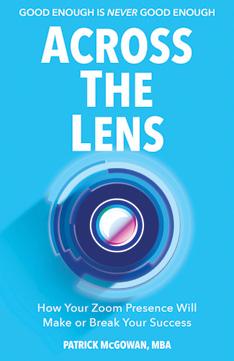
The best marketers see this work of positioning to be the first and most important activity. They have learned to be comfortable with discomfort, because good positioning feels limiting. Good positioning is uncomfortably narrow.
It’s a single, narrowly defined target buyer. A business’s videos — live and recorded — will improve once it’s determined for whom the business is producing the video and what the motivations are of those individuals.
2. Differentiation. What makes a business different is what gets people’s attention. Not different for different’s sake, but a viable, propositional difference that appeals to the business’s ideal buyer.
It’s a noisy, messy and chaotic market. Businesses want to be a brand, which means they can charge a premium. If there is nothing to distinguish a business from its competition, then it’s a commodity and it can compete only on price.
A business’s differentiation needs to be relevant and clearly expressed on all its video channels, especially video meetings. The first step is to shift responsibility for video meetings from operations to marketing. The next step, especially with a
32 INBUSINESSPHX.COM MAY 2023
PACKAGED TO IMPRESS
hybrid workforce, is to make sure that everyone who shows up on video is well trained and that their presence represents the value of the brand.
3. Distribution. Where a business should post its videos is determined by positioning and differentiation, not trend or fashion. A fishing guide once said, “You’re not fishing unless you have fish under your boat.” Or as Maverick said to Goose in the first Top Gun movie, “Target rich environment.”
Distribution can include everything from the social media platform (LinkedIn, TikTok) to the video distributor (YouTube, Vimeo) to the livestream platform. It answers what and how of a business’s video content strategy.
Regardless of platform, businesses want all their videos to do one thing: direct interested parties to their website. There, the visitors learn more about the business and begin to fall in love with it.
Distribution isn’t a benign decision. It says a lot about who the business is and the people it’s trying to reach.
4. Story. Stories draw prospects in and customers closer. A welltold story engages the right people into a deeper, more meaningful conversation.
The right story a business wants to tell elevates the customer as hero. It captures the business’s positioning and differentiation. How the business will tell its story — written, audible or visual — will be determined by the platform the business chooses and the audience it wants to reach.
TikTok is both a genre of video and a distribution platform. The audience consumes video through a spontaneous scroll. How a business tells its story on TikTok may not work on LinkedIn.
Additionally, a business’s video meetings, podcasts and livestream productions express the story of its brand. The way the business shows up on video tells a story. But is it the right story? The business’s video meetings and podcast presence need to set the tone and timbre of future engagements.
5. Surprise. Better video is an act of kindness. Business leaders should do everything they can to be more present across the lens. We all spend enough time in front of a camera. When we show up on camera with a better-than-expected presence, we surprise people. Surprise is one ingredient in being unforgettable.
When the person on the video is not present, people check out. When the person is present, people respond. Presence is what a person says before saying a word.
A person’s presence should communicate confidence, power and credibility. This will surprise some people. Combining it with confidence will make the person more persuasive.
A CRITICAL COMPONENT
Video content is a critical component to a business’s digital content marketing strategy. All video — whether meetings, podcasts, e-learning or social media — deserves careful review and attention.
Video is a powerful and compelling medium. These five rules provide the framework business leaders need to begin to evaluate what they’ve already produced and what they plan to produce.
Business leaders need to assert to themselves, “Video is how we do business now” — then go and do it.
The Secret to Getting Along (And Why It’s Easier Than You Think)
Conflict is everywhere — in our homes, at work, on our social media feeds. But conflict isn’t inherently bad … in fact, it’s a normal and healthy part of human relationships. But many of us aren’t good at managing conflict in our everyday lives. In The Secret to Getting Along (And Why it’s Easier Than You Think!), attorney Gabrielle Hartley brings more than two decades of divorce mediation experience to helping readers learn how to resolve conflict in ways that strengthen their relationships, reflect their values, and lead to positive outcomes for everyone involved. Whether it’s about dealing with a difficult family member a toxic co-worker, this book is a necessary resource for navigating difficult conversations and situations — and finding the solutions that will help readers create a peaceful, less stressful and more fulfilling life.
The Secret to Getting Along (And Why It’s Easier Than You Think): 3 Steps to LifeChanging Conflict Resolution

Gabrielle Hartley
Sourcebooks Available 5/16/2023
Walk Away to Win
$26.99
288 pages
Ranging from general conflict to psychological violence, workplace bullying has become an epidemic at many offices. The Workplace Bullying Institute reports that workplace bullying affects approximately 80 million workers. And with the Great Resignation upon us, we’re seeing that a toxic culture or manager is one of the top reasons employees leave a company. In Walk Away to Win, Megan Carle draws on her own experience as a target of workplace bullying — paired with the latest research in the field — to reveal how unhealthy workplace cultures enable this insidious behavior. She describes the impact of bullying on an organization’s bottom line and explains what individuals can do to combat bullying against themselves or their co-workers. The book also sends a message to leaders in business: If you tolerate workplace bullies, you’ll lose staff, productivity and market share.
Walk Away to Win: A Playbook to Combat Workplace Bullying

Make Work Better
320 pages
We’ve moved on from antiquated tools like typewriters or checkbooks, but bosses still rely on the same annual performance review process to manage employees the same way they did 70 years ago. It fails our modern hybrid workplaces and it doesn’t improve performance, especially for today’s millennial and Gen-Z workforce. It succeeds only in lowering employee engagement, undermining trust in management, decreasing transparency and increasing turnover. There must be a way to make work better for all of us. Featuring front-line insights from adopters of the process at Google, Intuit, Vertiv, PepsiCo and other leading organizations, Make Work Better gives readers everything they need to improve their organization from wherever they sit.
Make Work Better: Revolutionizing How Great Bosses Lead, Give Feedback, and Empower Employees

Doug Dennerline and Jamie Aitken
Skyhorse Available 5/23/2023
$30
216 pages
33 INBUSINESSPHX.COM MAY 2023
A business’s differentiation needs to be relevant and clearly expressed on all its video channels, especially video meetings.
Megan Carle $26 McGraw Hill Available 5/16/2023
BETTERING YOUR BUSINESS
En Negocios ECONOMIA / ECONOMY
Edgar R. Olivo es un educador empresarial bilingüe, asesor económico y colaborador de varios medios de comunicación. Es apasionado por la educación y comunidad. Está certificado en finanzas y análisis de datos y posee un título en negocios de la Universidad
Estatal de Arizona.
Edgar R. Olivo is a bilingual business educator, economic advisor and contributor for several media outlets. He’s a nonprofit executive who is passionate about education. He is certified in finance and data analytics and holds a business degree from Arizona State University.

Encuentra tu nicho: 5 consejos para elegir el negocio correcto
por Edgar R. Olivo
¿Estás cansado de trabajar para alguien más y listo para dar el salto al emprendimiento? Comenzar un negocio puede ser una excelente ruta hacia la independencia financiera, pero con tantas opciones, puede ser abrumador decidir qué camino tomar.
Aquí hay cinco consejos para ayudarte a encontrar la idea de negocio adecuada para ti:
1. Considera tus pasiones e intereses. Comenzar un negocio basado en tus pasiones e intereses puede ser una excelente manera de convertir tus pasatiempos en un emprendimiento rentable. Pregúntate: ¿Qué me encanta hacer? ¿Cuáles son mis pasatiempos? ¿En qué soy bueno? Por ejemplo, si te encanta hornear, podrías considerar comenzar una panadería en casa o vender tus productos horneados en mercados locales.
2. Identifica una brecha en el mercado. Busca oportunidades donde exista una necesidad que no se esté satisfaciendo. Identifica una brecha en el mercado y piensa
en cómo puedes llenarla. Por ejemplo, si notas una falta de opciones de comida saludable y asequible en tu comunidad, podrías considerar comenzar un servicio de entrega de comidas o abrir un camión de comida saludable.
3. Investiga las tendencias y mercados emergentes. Mantente al tanto de las tendencias de la industria y los mercados emergentes para identificar oportunidades de negocio. Investiga lo que actualmente está en demanda y lo que es probable que se vuelva popular en el futuro. Por ejemplo, con la creciente demanda de productos ecológicos y sostenibles, comenzar un negocio que ofrezca alternativas sostenibles a los productos cotidianos podría ser una gran oportunidad.

4. Aprovecha tus habilidades y experiencia. Comenzar un negocio que aproveche tus habilidades y experiencia puede aumentar tus posibilidades de éxito. Considera tu experiencia laboral anterior, educación y habilidades para identificar oportunidades de negocio. Por ejemplo, si tienes experiencia
¿Sabías que, según un estudio de CB Insights, el 42% de las startups fracasan debido a la falta de demanda del mercado? Por eso, es crucial encontrar tu nicho y elegir el negocio adecuado. Siguiendo estos 5 consejos para identificar oportunidades que se ajusten a tus pasiones, habilidades y tendencias del mercado, estarás mejor posicionado para triunfar en el mundo del emprendimiento.
34 INBUSINESSPHX.COM MAY 2023
en diseño gráfico, podrías considerar comenzar un negocio de diseño freelance o abrir una imprenta.
5. Resuelve un problema. Identificar un problema y crear una solución puede ser una idea de negocio rentable. Piensa en problemas comunes que enfrentan las personas y cómo puedes resolverlos. Por ejemplo, si el estacionamiento es un problema importante en tu comunidad, podrías considerar comenzar un servicio de gestión de estacionamiento que ayude a las empresas e individuos a encontrar y reservar lugares de estacionamiento.
El emprendimiento es una gran ruta hacia la independencia financiera. Comenzar un negocio te permite ser tu propio jefe, crear tu propio horario y controlar tus ingresos. Siguiendo estos consejos e identificando una idea de negocio que se alinee con tus pasiones y habilidades, puedes aumentar tus posibilidades de éxito y alcanzar tus objetivos financieros. Recuerda investigar, buscar consejos de emprendedores experimentados y estar preparado para dedicar el trabajo y la dedicación necesarios para hacer de tu negocio un éxito.
Find Your Niche: 5 Tips for Choosing the Right Business
by Edgar R. Olivo
Are you tired of working for someone else and ready to take the leap into entrepreneurship? Starting a business can be an excellent route to financial independence but, with so many options, it can be overwhelming to decide which path to take.
Here are five tips to help you find the right business idea for you:

1. Consider your passions and interests. Starting a business based on your passions and interests can be a great way to turn your hobbies into a profitable venture. Ask yourself: What do I love to do? What are my hobbies? What am I good at? For example, if you love baking, you might consider starting a home bakery or selling your baked goods at local farmers markets.
2. Identify a gap in the market. Look for opportunities where there is a need that is not being met. Identify a gap in the market and think about how you can fill it. For example, if you notice a lack of affordable and healthy food options in your community, you might consider starting a meal delivery service or opening a healthy food truck.
3. Research trends and emerging markets. Stay on top of industry trends and emerging markets to identify business opportunities. Research what is currently in demand and what is likely to become popular in the future. For example, with the growing demand for eco-friendly and sustainable products, starting a business that offers sustainable alternatives to everyday products could be a great opportunity.
4. Take advantage of your skills and experience. Starting a business that leverages your skills and experience can increase your chances of success. Consider your previous work experience, education and skills to identify business opportunities. For example, if you have a background in graphic design, you might consider starting a freelance design business or opening a print shop.
5. Solve a problem. Identifying a problem and creating a solution can be a profitable business idea. Think about common problems that people face and how you can solve them. For example, if parking is a major issue in your community, you might consider starting a parking management service that helps businesses and individuals find and reserve parking spots.
Entrepreneurship is a great route to financial independence. Starting a business allows you to be your own boss, create your own schedule and control your income. By following these tips and identifying a business idea that aligns with your passions and skills, you can increase your chances of success and achieve your financial goals. Remember to do your research, seek advice from experienced entrepreneurs and be prepared to put in the hard work and dedication required to make your business a success.
Did you know that, according to a study by CB Insights, 42% of startups fail due to a lack of market demand? That’s why it’s crucial to find your niche and choose the right business. By following these five tips to identify opportunities that align with your passions and skills and the market trends, you’ll be better positioned to succeed in the world of entrepreneurship.
35 INBUSINESSPHX.COM MAY 2023
ENGLISH TRANSLATION
DON’T NEGLECT TAX STRATEGY
Taxes can impact the business sale transaction as well as the proceeds from the sale itself. It’s important to understand how federal and state taxes will apply, as well as other potential liabilities, such as estate taxes. The structure of the business, the sale and its terms all factor into tax impact. It’s important that business owners not neglect tax strategy when planning a business acquisition.
Position Your Business for Acquisition
It takes time to develop and execute a strategic plan
by Elizabeth Hale, CPA
Many entrepreneurs launch their companies with an eye toward eventually selling them. But preparing a business for an acquisition is not as simple as making the decision to sell.
The process can be complex and take several years, depending on objectives and the state of the business, which can leave the founders or owners unsure of where to begin.

Regardless of company or industry, there are several steps entrepreneurs and business owners who are exploring a sale of their company can take that will allow them to create a strategic plan of action for successfully selling their business.
Step 1: Reflect on the why. Before setting anything in motion, it’s critical first to look inwardly and reflect on the reasons behind wanting to sell.
Every entrepreneur occasionally fantasizes about selling out and retiring to a beach somewhere, leaving behind the long days and sometimes even longer nights building their legacies. But it’s highly unlikely that’s the true reason behind pursuing a sale.
Some entrepreneurs pursue an acquisition because they feel overwhelmed. Others want to relinquish responsibilities and become an employee of a larger organization.
Regardless of the reason, entrepreneurs considering a sale of their company must take time to deeply reflect on the reasons they want to sell. Knowing and understanding the why will determine how they navigate the rest of the process.
Step 2: Recruit a team. Selling a business is a multifaceted process that requires a highly qualified team of experts. Entrepreneurs will want to recruit a team of trusted lawyers, accountants, investment bankers and other professionals.
With extensive familiarity with the entire process, these are the individuals who will begin assessing the state of the business, perform preliminary due diligence, research potential buyers and more.
Step 3: Get finances and records in order. Perhaps the most critical step in preparing a business to sell is ensuring company records are in tip-top shape.
shedding any excess and unnecessary products or processes. Are there underperforming SKUs or services? It’s time to eliminate those and focus on profitable ones. What about key people? Is the business staffed with individuals who can run the organization without help from the founder or owner?
A streamlined, profitable company is much more likely to attract interest from buyers and command a higher sale price.
Step 5: Develop a smart tax strategy. Once the core business clean-up effort has taken place, business owners should work to develop a smart tax strategy that will minimize the amount of taxes owed at the time of sale. This is particularly important when it comes to structuring the deal, as both buyer and seller will want to limit their respective tax liabilities.
Elizabeth Hale, CPA, transforms growthminded companies and demystifies complex tax strategies as CEO of eeCPA. For more than 30 years, she has helped entrepreneurs, investors, family offices and commercial real estate developers pinpoint new and creative avenues for growth while mitigating risk. eecpa.com

MAY
These are the documents that investment bankers and business brokers will use to price the company and determine how much they can list it for.
Potential buyers also will rely on financial statements and company records to determine profitability and potential as they decide whether they wish to pursue an acquisition or not.
If records and financials are in poor shape, it can cause numerous headaches and setbacks that could include a lowerthan-warranted price, delaying the sale or possibly derail the process altogether.
Step 4: Simplify and streamline the business. Profitability is always critical. But when a sale is on the horizon, its importance skyrockets. Potential buyers will want to know the business is lucrative and that it operates smoothly. This is the point in the process where entrepreneurs should focus on
Before reaching that stage, however, founders should discuss available tax scenarios and options with their business sale teams to set themselves up for success and determine their preferred approach. There are certain tax-saving tactics, such as setting up trusts or nonprofits, that only can be done before the sale closes, making pre-planning for taxes essential to the process.
Step 6: Be patient. Selling a business is a marathon, not a sprint. Entrepreneurs should prepare to practice their patience as they work to ready their companies for an acquisition.
A good rule of thumb is to anticipate a minimum of six months to sell a business. However, depending on unique circumstances and other factors, that timeline could stretch out to two to three years, or even longer.
Regardless of how long it takes, entrepreneurs need to take the time to develop and execute a strategic plan that achieves the objectives they set out for the sale. The ultimate goal is to facilitate a sale that will be successful and set them up for their next chapter.
Generally, a small business is worth anywhere from 25% to 300% of its annual sales. The median sale price of a small business sold in 2022 was $315,000, according to BizBuySell, and the median revenue of sold businesses was $650,000.
36 INBUSINESSPHX.COM
2023
Economy DEVELOPING & GROWING BUSINESS DYNAMICS
Do you value your investments?

Let us protect what drives you!


Hani Sayed is a partner and chair of the Intellectual Property and Automotive Practice at Rutan & Tucker, LLP. His experience is technology extensive and covers products, processes and designs in mechanical, healthcare, information technology, material sciences, medical devices, computer networking, memory devices, electronics, gaming, apparel, nutritional supplements and biotechnology along with entertainment, sports and media. rutan.com
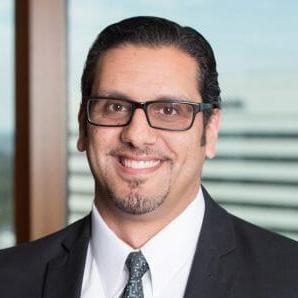
How Do I Ward Off Counterfeits?
Strategies to stay alert as so much business is transitioning to E-commerce
by Hani Sayed
After nearly three years of pandemic-sized changes in all our lives, we seem to finally be over the COVID hump. While we’re all excited for the return to normalcy, some things will never be the same. For example, the hybrid or remote working environment has fundamentally changed the work atmosphere. Work dress codes have morphed from business casual to something resembling a cross between pajamas and workout gear. Most likely, the biggest transition over the last three to five years is the transition from traditional brickand-mortar stores, restaurants and event venues to online entertainment, on-demand food delivery and the world of e-commerce for all our daily needs. Almost gone are the days of having to drive to a store to pick up essential items. Today, almost everything can be ordered online and delivered to our door in a matter of days if not hours.
With this transition from traditional marketplaces to e-commerce, business owners operating online face additional risks. For brand owners, the risk of counterfeits has skyrocketed since the outbreak of COVID. According to some estimates, counterfeits cost legitimate businesses upwards of two billion dollars a year. So, what legal issues must businesses consider in regard to counterfeits and, importantly, how do they ward them off?
PROTECTING ONE’S BRAND
The essential pivot to e-commerce resulted in greater brand exposure and exponential growth for many businesses; however, it is imperative that these businesses now protect their brands. How?
Trademark ownership, copyrights and other valuable IP: It’s important businesses protect all their brand names, product names, photos, graphics, and other content online. The best way for them to do this is to register their trademarks and copyrights with the United States Patent and Trademark Office or the United States Copyright Office. Registration is the first step to proper protection and provides the ability to enforce against bad actors who attempt to steal branded content and then represent it to the consuming public as their own.
Domain Names: Although a company should utilize only a single domain for business use, the concept of purchasing a defensive portfolio comprised of variations of its brand (which the business can park or redirect to its main site) is a good idea. This includes .org and .net versions of the .com domain. It is not uncommon for bad actors to purchase domain names capitalizing on common typos or misspellings for their benefit. Similarly, it’s important companies register the corresponding social media handles for their brands.
MONITORING ONE’S COMPETITION
It is key that businesses know their marketplace and their competitors. There are several resources that can be utilized to keep an eye on the competition and the marketplace as a
whole and detect bad actors and counterfeit products online. Additionally, most online marketplaces such as Amazon, eBay and the like have brand protection programs to help police registered brands. Additionally, Google Alerts may help businesses track both competitors and mentions of their own brands and/or products online.
It’s important businesses spend time watching for potential problems online. Simple searches online of their brands and products will often result in problematic results. Taking the time to police their brands will help to adequately protect them.
COUNTERFEIT CLAIMS
For a business to decide whether it needs to file a counterfeit claim against a bad actor, it must first determine whether the counterfeiter is actually violating the law. Under the law, a counterfeiter utilizes an illegitimate mark (brand) which is identical with, or substantially indistinguishable from, a registered trademark. Essentially, counterfeits are products that emulate a business’s goods in their entirety to deceive online purchasers into believing that they are buying the authentic goods.
What a business should look for: (a) Use of its brand/ trademark; (b) use of its logos or close association of its logos; (c) similar colors and advertising styling; and (d) use of the business’s pictures, descriptions or other content to make it look like they are selling authentic product. Each of these are a good indicator that a business may need to file a counterfeit claim with the appropriate agency. It is always helpful that a business finds a good attorney or counsel that can provide it with resources and knowledge to help protect its brands and enforce its rights.
According to some estimates, counterfeits cost legitimate businesses upwards of two billion dollars a year.

38 INBUSINESSPHX.COM MAY 2023
LAW MATTERS TO BUSINESS

Albuquerque | Boise | Dallas | Denver | Las Vegas | Los Angeles | Los Cabos | Orange County Phoenix | Portland | Reno | Salt Lake City | San Diego | Seattle | Tucson | Washington, D.C. Two double-shot macchiatos before 10, then it’s decaf all the way. Chai tea, soy latte, or regular joe, we make it our priority to understand what makes you, you. In doing so, we address your legal needs with a uniquely tailored approach. Find out more at swlaw.com
Tyler Butler is a chief social impact officer for a publicly traded corporate portfolio where she leads programs that positively impact humanity. She is also the founder of 11Eleven Consulting, and she is often cited as a subject matter expert by Forbes, SHRM, Entrepreneur, U.S. News & World Report and more. linkedin.com/in/tylerbutler
Optum for Optimal Health Over 55

And for quality healthcare without barriers
by Tyler Butler
Optum Care has been a leading healthcare provider since 2011, serving more than 19 million patients across the United States. From California to Pennsylvania, Optum is committed to advancing health equity, envisioning a world where local communities can provide equal access to quality healthcare without any barriers.
To achieve this vision, Optum focuses on building trust, expanding access and tailoring support to meet the unique needs of individual communities. Ben Brock, Optum Community Centers director, says, “Health inequity is a risk as great as any, but we have the tools, the partnerships and the will to address it together.”
In Arizona, Optum has made a pledge to support the senior population, recognizing that everyone should have the opportunity to live a full and healthy life. The company is committed to improving access and removing obstacles so people can get the care they need, when and where they want it.
Optum offers personalized care that is close to home, with its community centers focused on those aged 55 and older, including Medicare patients. Optum operates as a part of the community and is committed to engaging the entire community, not just its members and patients. One of Optum’s core engagement efforts is the Optum Community Centers, which are neighborhood hubs for all seniors in the community.
Optum has a deep network of more than 3,600 healthcare providers in the Phoenix Metro and Tucson region for regular health and wellness needs. The company offers remote wellness options for convenience, such as a 24/7 telephone advice nurse line and quick-care video visits, along with inhome wellness exams and care visits when needed.
Optum is proud of its focus on communities and health equity. The company prides itself on offering the highest quality of care and doing all it can to serve those in underserved and at-risk populations, including the elderly.
Optum has six community center locations across the region, including one in Tucson and the newest one just opened in East Mesa. These centers welcome all seniors in the community to gather, grow, and stay well together. They offer free social events, fitness classes led by experts, and health and wellness presentations by Optum healthcare professionals, all operating in an open, inviting environment.
While the focus of Optum’s community offerings differs from market to market, each program strives for greater health equity, particularly for those who are financially disadvantaged or have a disparately high prevalence of health complications. Optum partners with a number of organizations both company-wide and locally to tackle health equity issues on macro and micro levels.
This includes a nationwide partnership with One World Surgery and localized support of national organizations such as the American Heart Association, Dress for Success, the

American Cancer Society and others. Beyond the Community Centers’ work with the nonprofits mentioned, and others, Optum Arizona works hand in hand with American Heart Association and will be sponsoring the 2023 Heart Walk in Phoenix and Tucson.

Another partnership with Southwest Human Development engaged seniors for a bag painting event in conjunction with Grandparents Day. The site coordinator collaborated with the Art Workshop instructor to facilitate a plan for the event. Together with seniors, they created 50 bags that were subsequently delivered to Southwest Human Development and given to local foster children on Grandparents Day. Similarly, Optum Community Center staff and seniors also supported Southwest Human Development Gingerbread Kids drive, providing gifts for 30 children in need.
“Our partnership with Optum’s Community Centers goes back more than five years, and the Southwest Human Development team could not be more grateful for the support that we’ve received. From our Back to School and Gingerbread Holiday Toy drives to decorating bags for children in foster care, the Optum team always goes above and beyond to support children right here in Arizona,” says Jake Adams, chief development officer for Southwest Human Development.
Locally, Optum’s Arizona Community Centers have been working with St. Mary’s Food Bank since the summer of 2020. To support the community through the worst of the pandemic, they set up hours for each community center to accept contactless drive-by food donations weekly. Once in-person activities in the centers resumed, they decided to continue the food drives indefinitely. Between staff and members, they have donated over 6,500 pounds of food since August of 2020.
As Ben Brock, Optum Community Centers director, shares, “Human beings are social animals, and this is true regardless of age. We need to be with each other, and Optum Community Centers bring seniors together to improve their overall health and well-being.”
Optum partners with a number of organizations both company-wide and locally to tackle health equity issues on macro and micro levels.
40 INBUSINESSPHX.COM MAY 2023
Photo courtesy of Optum
Optum optum.com Optum Community Centers optum.com/azcommunitycenters Social Impact BUSINESS GIVES BACK




Bruce Weber is founder and president/CEO at Weber Group. Weber brings more than 20 years of experience to the for-profit and nonprofit community, working with startup, growth and mature organizations. His focus is in strengthening organizations through strategic planning, organizational development, leadership and board development.
He is a BoardSource Certified Governance trainer and a founding partner of the Nonprofit Lifecycles Institute. webergroupaz.com

Listening Is the First Step
Business leaders need to listen to their employees and to their business
by Bruce Weber
Listening is a powerful tool in any business setting and a critical skill that can enable a business to understand what its employees need, what they desire in their work, and how the business can become more successful. Listening, however, can be challenging for many business owners and managers who are often focused on the bottom line, meeting targets and achieving goals.
It is essential business leaders listen to their employees to build a strong and successful team and business. When employees feel heard and valued, they are more likely to be engaged and motivated, leading to improved productivity and business outcomes. Listening to staff also demonstrates that the leadership cares about them and their concerns, which often leads to higher employee retention rates.
Recently, a friend who owns a legal firm shared a dilemma that we are all too familiar with: getting people to return to the office. In his law practice, it was vital to have staff in the office to facilitate the daily activities necessary. When it was safe to do so, he informed everyone that they needed to return to the office full time but met with a great deal of resistance. He wanted to be accommodating, but the firm’s clients had specific needs that required in-office participation. As a strong leader, he listened to the reasons why there was reluctance. Folks with young families wanted extra schedule flexibility, and others liked the ability to plan and have more free time. Together they arrived at a compromise: Half the staff would take off every other Friday. It would mean Fridays and Mondays would be busier for those working but all agreed the idea had merit. The outcome is that the staff loves it, and morale and
client satisfaction has never been higher. By engaging the staff in the decision, everyone won.
Another method of listening to employees is to conduct regular surveys or focus groups. Surveys can help leaders understand what their employees are thinking and feeling about their work and the business. It can also provide insight into what areas of the business need to improve. Focus groups can also help leaders dig deeper into specific topics and gain a better understanding of their employees’ thoughts and opinions.

Listening to employees also means acting on their feedback. It is not enough to just listen. As the earlier example demonstrates, action is critical to meaningful employee dialogue and demonstrates that leaders value their input and are committed to making positive changes to enhance their work environment.
It is also important to listen to the business! Leaders should regularly review the business’s performance to identify areas of improvement and make necessary adjustments to remain competitive. Financial data, customer feedback and employee engagement surveys can all provide insight into how successful the business has been and what opportunities lie ahead.
Listening to both employees and the business is critical in building a successful, sustainable organization. Creating an open-door policy, conducting regular surveys or focus groups and acting on feedback builds a workplace culture that values the input of its employees and stakeholders. Remember, listening is only the first step; action is what truly drives positive change in a business!
“Cultures of dialogue are not only full of happier, more engaged employees — they also reap the kind of bottom-line results that can mean the difference between success and failure.” David Maxfield, New York Times Author
42 INBUSINESSPHX.COM MAY 2023
Capacity FOR-PROFIT & NONPROFIT GROWTH
The Influence and Impact of Small Businesses on Community
And making a difference with nonprofit partnerships
by Sam Leyvas
Small businesses are the backbone of community. For many, owning and operating a small business has been the fulfillment of “The American Dream.” Whether it’s opening their own bakery or starting their own contracting firm, many people have a personal story of what made them go into business for themselves.
Although the idea initially might be for self-sufficiency or to be their own boss, being better connected to their local community is an overlapping message of their “why.” Partnering with nonprofits helps drive the business’s value by reaching more people through philanthropic engagement. The overall impact of this kind of relationship can help be the bridge between business and the many challenges that communities face, even at a neighborhood level.
SMALL BUSINESSES CREATE JOBS AND SUPPORT LOCAL ECONOMIES
Small businesses are collectively the largest employers in local communities and help to create a diverse and vibrant local culture that can attract visitors and boost tourism. Comprising more than half of Arizona’s total workforce and totaling more than $71 million in local income and wages, Arizona small businesses have created hundreds of thousands of jobs. They also contribute upward of $10 billion each year in Arizona state and local tax revenue that is used to fund local services, public safety, schools and infrastructure improvements.
Many small businesses also tend to support one another by purchasing products from each other. For example, a restaurant owner might source only locally grown and raised produce and meat, or an art gallery may choose to display only works from local artists. This kind of revolving interaction creates a ripple effect throughout the community, while also creating a strong community for its residents.
PARTNERING WITH NONPROFITS CREATES STRONG COMMUNITY
Small businesses are often deeply connected to their local communities. They are more likely to participate in community events and support causes, which helps create greater connections among the people, places and happenings in local neighborhoods.
When a business chooses to partner with communitydriven organizations, common ground is created between the business and its employees and customers. Having a sense of social responsibility is important to consumers — and they certainly take notice. Partnerships that support charitable causes can help businesses align their values as a company with those of their stakeholders. This has been proven to positively impact a company’s long-term sustainability.
The issues that matter the most in our community — like decreasing homelessness, improving education and increasing access to affordable healthcare — are too complicated for any one organization to tackle alone. Through collaborative partnerships, businesses and nonprofits are provided greater opportunities to best meet the needs of their community through collective impact. Whether through volunteering or providing financial or in-kind donations, there are countless ways businesses can help make communities stronger and more prosperous.
SOME WAYS SMALL BUSINESSES CAN PARTNER WITH NONPROFITS
• Sponsoring events: Small businesses can sponsor events or initiatives organized by local nonprofits. This can help the nonprofit raise funds and awareness, while also providing the small business with exposure and positive public relations. Events can include galas, short-term supply drives, golf tournaments, luncheons and more.
• Volunteering: Small businesses can encourage their local employees to volunteer with charitable causes. This can help build stronger connections between the business and the community while also providing valuable support for the nonprofit’s mission. Volunteer engagement activities can include sorting and packing emergency meals at a local food bank, installing and maintaining community gardens at local schools, or even serving on a nonprofit board.
• Donating: Financial and in-kind support helps fuel and drive philanthropic work. Small businesses can donate products or services to nonprofits, when needed, or can donate financial resources through company proceeds, employee giving campaigns — or both! They can also provide important pro bono services such as marketing and graphic design.
• Engaging in cause marketing: Small businesses can create cause-marketing campaigns that donate a portion of sales to a nonprofit. This can help raise funds for the nonprofit’s programs while also promoting the business and its products or services.
A business’s first step can be talking with its customers, employees and neighbors to find out which causes mean the most to them. Businesses may also reach out to trusted philanthropic collaborators like the Alliance of Arizona Nonprofits, Valley of the Sun United Way and other community and educational foundations, or research a nonprofit’s history and rating through vetting organizations like Candid/Guidestar and Charity Navigator.
What matters the most is picking a trusted partner that will resonate with the business’s stakeholders to create meaningful and lasting change.
Partnering with nonprofits helps drive a business’s value by reaching more people through philanthropic engagement.
Sam Leyvas is vice president of corporate relations and social responsibility for Valley of the Sun United Way. A current project at VSUW is its journey to Mighty Change 2026. vsuw.org/mightychange
43 INBUSINESSPHX.COM MAY 2023
INVESTING IN COMMUNITY
Rick Jackson is the campus director for National Technical Institute, a state-approved trade school serving students in Phoenix and the surrounding areas. With campuses in Las Vegas, Phoenix and Houston offering fast-track training in HVAC, plumbing and electrical, NTI’s mission is to produce problemsolving, creative-thinking graduates who possess industry-standard knowledge and skills for a long-term, promising career. ntiphoenix.com
Use an Advisory Board to Benefit a Business
Seasoned, impartial experts add market strength
by Rick Jackson
We can probably all agree that many businesses often operate with scarce resources and limited expertise, sometimes making it challenging to navigate complex business decisions. However, if a business owner had the opportunity to solve this problem by consulting a team of experts solely dedicated to providing guidance based on previous experiences, wouldn’t they take it? I am sure most business owners would be eager for that type of access. Fortunately, it’s possible. And at National Technical Institute, it’s been a resource that has made us stronger.
NTI’s advisory board meets twice a year and they have become an invaluable asset. We teach HVAC, plumbing and electrical trades, and the board is comprised of contractors and trade-related business owners who assist in planning the curriculum to ensure students acquire the knowledge required by potential employers. NTI’s advisory board members are invested in the success of NTI’s graduates, as they could potentially employ them, given the current shortage of qualified workers. As a result, they are enthusiastic about helping to create an excellent learning experience.
ADVISORY BOARD VS. BOARD OF DIRECTORS
An advisory board consists of external advisors who provide advice to a company’s management team. They are not necessarily involved in the day-to-day operations of the company and do not have legal or fiduciary responsibilities. It is simply a tool to access expert consultation, usually focused on a specific area of the business, but not involved in the overall management of the company.
A corporation’s board of directors, on the other hand, generally must be elected or appointed by leadership. They have legal and fiduciary responsibilities; are obligated to the company’s shareholders; and responsible for making strategic decisions, setting policies and goals, and overseeing the company’s financial performance.
AN OVERLOOKED WEALTH OF KNOWLEDGE
Most business owners overlook creating an advisory board, or do not know that this type of set up can be a benefit and can often be relied upon to offer sound business and financial advice. A team of expert advisors providing high-level strategic planning and direction without being bound by board decisions can be an invaluable tool. And, since an advisor generally does not have the fiduciary and legal responsibility of a director, he or she may offer advice more freely. For this reason, some corporations have an advisory board as well as a formal board of directors.
When forming an advisory board, it is important to be honest and recognize the areas where expert advice could be the most helpful. This is key to supplementing an owner’s knowledge and providing guidance. Once these areas are
identified, business owners can pinpoint potential advisory board members possessing the relevant skills and expertise and establish a plan for the board’s operations. It’s helpful to go through personal contacts that include former colleagues and clients as well as trade associations and institutions. Given that some of these individuals are likely to be highly soughtafter experts in their respective fields, compensation or equity incentives may be necessary.
Investing the time and effort required to establish a strong advisory board can be invaluable, given the numerous benefits that impartial outsiders can provide.
Access to Expertise: Advisory board members should have years of experience in their respective fields and can offer insights on topics such as marketing, sales, finance and operations. This guidance can assist business owners in making informed decisions, avoiding costly mistakes. A CEO could be perfect here, one who has built and scaled teams, raised capital and made difficult decisions.
Objective Feedback: Having access to an independent sounding board could be invaluable to help refine business strategies and improve operations. Members who come from the same industry are helpful in understanding the target customer.
Networking Opportunities: Advisory board members who are well-connected individuals with extensive networks can provide business owners with valuable networking opportunities that can help grow and expand operations.
Improved Credibility: An association with respected individuals can only boost a business’s reputation and bring a new level of awareness.
Increased Accountability: By regularly reporting to an advisory board, business owners can stay focused on objectives and avoid getting sidetracked by day-to-day distractions.
Strategic Planning: Strategic planning is vital for any business for growth and expansion, and an advisory board can help business owners identify new opportunities and develop strategies.
Diverse Perspectives: Bringing together individuals from different backgrounds and industries helps business owners see things from different angles. A variety of perspectives from people with experience helps business owners gain fresh insights and find opportunities that are, possibly, being overlooked.
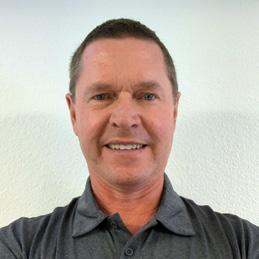
Having access to seasoned, knowledgeable experts helps business owners make better decisions, avoid costly mistakes and grow operations.
NTI’s advisory board members are invested in the success of NTI’s graduates, as they could potentially employ them, given the current shortage of qualified workers.
44 INBUSINESSPHX.COM MAY 2023
OUR SUBJECT IN-DEPTH
2023 MercedesMaybach S 580 4MATIC


Grille blades shimmer. Pillar emblems glow. Paintwork and chrome accentuate flowing lines and a confident stance. That’s the new Mercedes-Maybach S 580 4MATIC. The cabin is the work of 16,000 needles in unison, and several pairs of expert hands. It is the ultimate production luxury sedan on the road. Biturbo torque, from a V8 or V12, is apportioned to all four wheels with constantly calculated precision. Changing weather or winding road, 4MATIC® sends power to the wheels that can use it best. AIRMATIC® suspension can adapt and self-level at each wheel to minimize the motions felt by passengers. E-ACTIVE BODY CONTROL, an S 580 option, can
watch the road and respond in milliseconds. The rear wheels can turn up to 10 degrees opposite the fronts for tighter lowspeed turns. Subtler angles in either direction can intelligently enhance higher-speed stability and lane changes. From a warm welcome to a “hot stone” massage, every moment in a Maybach is time well spent. Legroom is expansive, with room to recline as passengers enjoy the extensive amenities. Every surface conveys the depth of engineering within. Wheels from 19 to 21 inches include polished, forged and fluted designs. Twenty-five paint choices include 10 distinctive two-tones. Thirty speakers include inseat resonators to deliver Burmester® High-End 4D sound that can be both heard and felt. Sound can be tuned to individual seats. Ear-level speakers guide the driver discreetly. Generosity in standard fitments leaves only a short roster of options. Among them are twin lounges divided by a woodtrimmed console. Bespoke handcrafted flutes are a thoughtful addition. The digital cockpit responds to natural spoken requests, or via touchscreens and a tablet. Climate and seating comforts tend to passengers individually. Music, lighting, massage and aromatherapy rival what’s enjoyed at a favorite spa. It is pure luxury. —Mike

Mercedes-Benz mbusa.com
Cultural Asset Strengthens Our Community

Presenting an extraordinary range of classical and popular programming, The Phoenix Symphony’s 2023-24 Season, its 77th, brings classical masterpieces, world-class guest artists, and new concert experiences to the Valley from Symphony Hall and the Mesa Arts Center to the Orpheum and Arizona Financial Theater.
“The breadth of programming in our 2023-24 Season reflects our innovative, dynamic and vibrant community in Phoenix and Arizona,” says Peter Kjome, president and CEO. “The Phoenix Symphony is one of Arizona’s most important cultural assets, and this season includes extraordinary programs that will enrich the lives of Arizonans of all ages.”
As part of the Classical programming, The 77th season opens and closes with two important programs led by Virginia G. Piper Music Director Tito Muñoz. Joined by The Phoenix Symphony Chorus and Phoenix Boys Choir, the season begins in September with Carl Orff’s
Hunter
mighty cantata, Carmina Burana. The Classics series concludes in May 2024 with Mahler’s Symphony No. 2 in C Minor, “Resurrection,” joined by The Phoenix Symphony Chorus.
The extensive lineup of Pops concerts includes a tribute to the music of ABBA with the Finnish vocal sensation Rajaton as well as “And I Love Her: The Beatles Reimagined” with Steve Hackman, featuring reimagined songs by the Fab Four.
Subscriptions are available now. Traditional Classics and Pops subscription packages are returning this season and are on sale with savings of up to 20% off single-ticket prices. Subscriptions for the 10-concert Classics series start at $250, including fees. Along with separate packages for the Classics, Pops and Films series, concertgoers can Create Your Own series by bundling four or more concerts while enjoying the same 20% off savings. —Mike Hunter phoenixsymphony.org
Wilhelm Maybach: In 2014, Daimler announced production of an ultra-luxury edition of the Mercedes-Benz S-Class under the new Mercedes-Maybach brand. Named after an early pioneer in the combustion engine development that ultimately led to the birth of Mercedes, the brand has evolved to its uber-luxury models sold today.

City: 15 mpg
Hwy: 24 mpg
Transmission: 9-speed automatic 0-60 mph: 4.7 sec.
45 INBUSINESSPHX.COM MAY 2023 BUSINESS Special Section: 11 Top Business Organizations You Must Know INBUSINESS BRICK-AND-MORTAR and ‘Flatlining’ Strategies Dangers of ‘Quiet Promotion’ This Month’s Guest Editor Kate Borders Downtown Tempe Authority THIS ISSUE Global Chamber Changing Requirements Data Privacy Why BusinessesBrick-and-Mortar AreBooming Retail on Top
MERCEDESMAYBACH S
4MATIC MSRP:
2023
580
$184,900
DON’T MISS OUT! Get a year of In Business Magazine Subscribe now at inbusinessphx.com
Photos courtesy of Mercedes-Benz
WE VALUE WHAT WE OWN
BREW HOUSE (PERSONAL PIZZA)
Pepperoni, sausage, caramelized onions, mozzarella, red sauce and fresh basil
$9
PRETZEL BITES
Caraway, Arizona Gold cheese fondue, Iron Horse Porter mustard
$9
PHX Beer Co.’s Downtown Taproom Puts the Brewery on View
It has been a few years since PHX Beer Co.’s Brewery and Taproom in Downtown Phoenix became a fan favorite addition to the craft beer scene in Arizona.
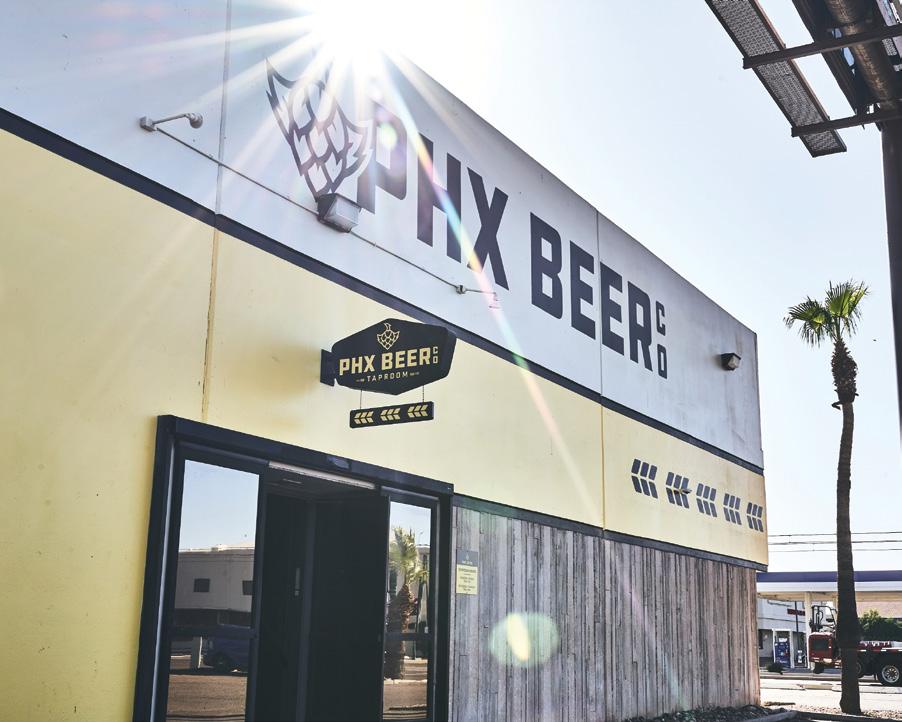
Since its opening in 2019, the staff has been working to expand the taproom’s menu, adding sharable items such as house-made chips and salsa plus the pretzel bites paired with Arizona Gold cheese fondue and Iron Horse Porter mustard.
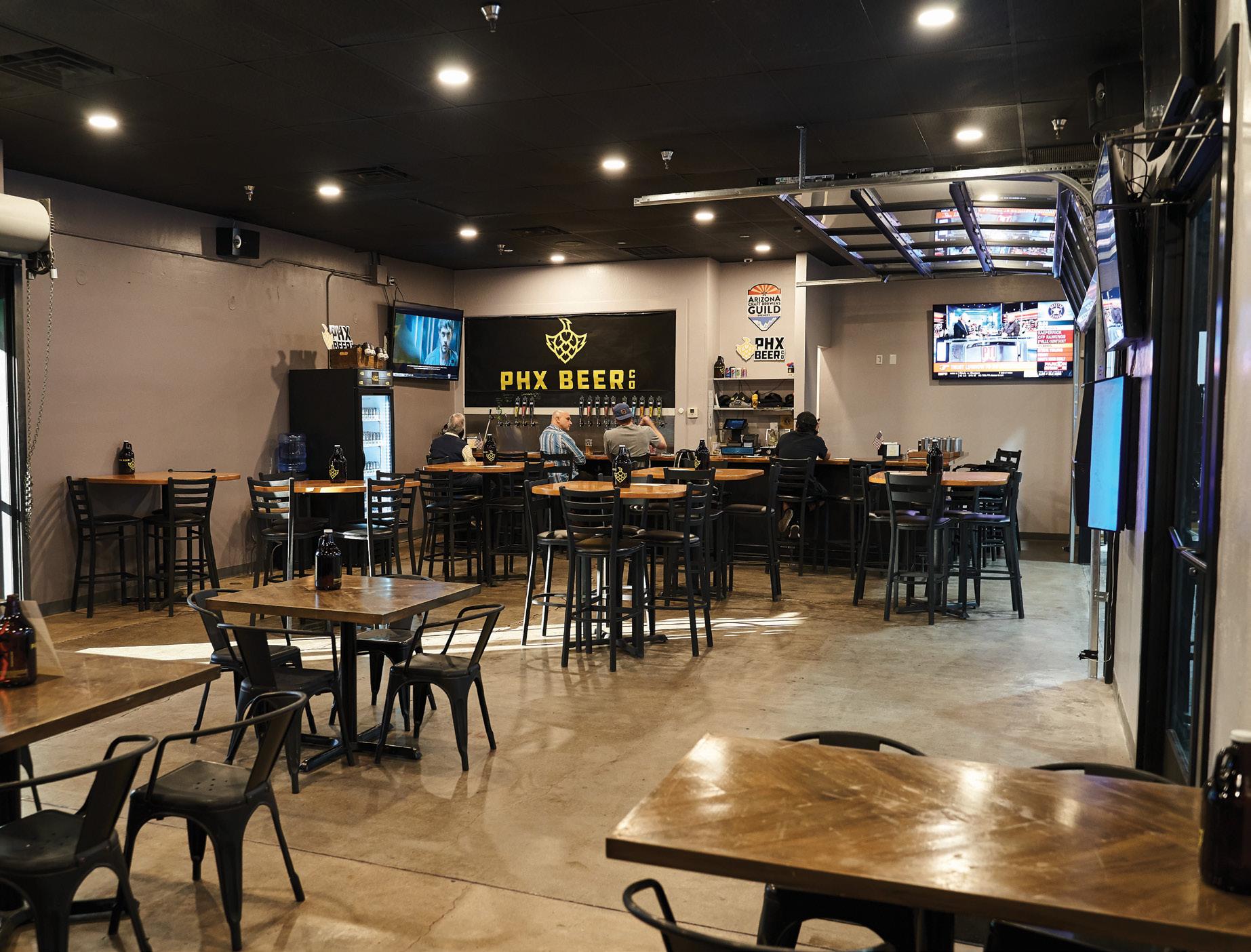
TAPROOM BRAT
Oven-cooked brat served on a toasted bun with Dijon mustard and sauerkraut $10
Guests stopping in for a quick lunch can also indulge in an oven-roasted brat or a selection of flatbreads like the Melrose, served with house sauce and a secret mixture of cheese blend,

and the Sonoran, served with calabrese salami, mushrooms, mozzarella, red sauce and Hatch chili jam.
To wash down these delicious bites, PHX Beer Co. offers 12 year-round beers, among them the Arizona Gold, Sunset Sour, Bird City Lager and award-winning Monsoon IPA. Guests can keep up to date on the changing selection of limited releases on PHX Beer Co.’s Instagram site.
The brewers at PHX Beer Co. also create beers to pair with standout menu items, like the fan favorite Monsoon IPA paired with the Brew House Flatbread. The Brew House is made with pepperoni, so the kick of the IPA brings out the spice of the meat while also balancing the saltiness.

At the Downtown Taproom, guests can dine in the main area, furnished with both high- and low-top tables and a full bar. Off to the side of the taproom, there are barn doors that can transform the space for private events, large parties and more. The entire tap room can also be rented out. Additionally, garage doors open to the brewery so guests can get a front row seat to the beer making process.
For longer lunches and teambuilding opportunities, there are interactive elements at the restaurant that include games of cornhole, darts, foosball and shuffleboard. —Adam Wojcik, brewery director at PHX Beer Co.
PHX Beer Co. Brewery and Taproom
3002 E. Washington St., Phoenix (602) 275-5049
phxbeerco.com

Many menu items actually use PHX Beer Company’s beers in the recipes.

46 INBUSINESSPHX.COM MAY 2023
Photos courtesy of Adam Wojcik, brewery director at PHX Beer Co.
MEALS THAT MATTER
aztechcouncil.org
IN THIS ISSUE
Coming Clean
New committee, member program focus on energy alternatives
Taking the Lead
SciTech Institute e orts give birth to statewide STEM Ecosystem Web Works
Improvements to Council’s site pay o Taking the Lead Preferred Business Partners program lightens the load
WHO WE ARE
Phoenix O ce
2800 N. Central Ave., #1530, Phoenix, AZ 85004 Phone: 602-343-8324 • Fax: 602-343-8330 info@aztechcouncil.org
Tucson O ce
1215 E. Pennsylvania St., Tucson, AZ, 85714 Phone: 520-388-5760 tucson@aztechcouncil.org
MANAGEMENT AND STAFF
Steven G. Zylstra President + CEO
Laura DeGeorge Chief of Sta
Deborah Zack Vice President, Membership Services
Karla Morales Vice President, Southern Arizona Regional O ce
Bianca Buliga Director, Marketing + Communications
Darryle Emerson Director, Programs + Events
Jamie Neilson Director of Operations + Events, Southern Arizona Regional O ce
Angelica Espinoza Bookkeeper
Sara Beschloss Administrative Assistant
Don Rodriguez Editor
Ron Schott Executive Emeritus, Phoenix SCITECH INSTITUTE
Steven G. Zylstra, President + CEO
Jeremy Babendure, Ph.D., Executive Director
Kelly Greene, Chief Operating O cer
Kaci Fankhauser, STEM Ecosystem Development
Claire Conway, STEM Ecosystem Programs Manager
Jake Lounsbury, Director of Global Partnerships
Brooke Maydwell, Education Outreach Coordinator
Sarah Cundi , Arizona CSO Regional Lead
Eileen Healy, CSO Program Coordinator - Latin America
Arizona Technology Report
Arizona Technology Council: The Voice of the Technology Industry

President’s Message
As a member-supported organization, it might be easy to believe the Arizona Technology Council exists only to support businesses that are up and running. But we believe a key part of our mission is to help develop the workforce of tomorrow.
A prime example is our support of Arizona State University’s AZNext initiative, a combination of the university’s rst U.S. Department of Labor (DOL) $2 million grant focused on developing 1,600 apprentices to ll information technology (IT), cyber and data roles and its second $8 million DOL grant to establish the Arizona Workforce Training Accelerator Partnership for Next Generation Jobs (AZNext).
The workforce development effort will enhance regional competitiveness, helping to address workforce shortages and train workers for high-paying, high-demand jobs in advanced manufacturing, cybersecurity and IT.
Led by ASU’s W. P. Carey School of Business, Ira A. Fulton Schools of Engineering and New College of Interdisciplinary Arts and Sciences, and community partners that include Pipeline AZ, Arizona Commerce Authority (ACA) and Arizona@Work, the second grant program is designed to train at least 2,000 participants, with a goal of achieving industryrecognized credentials and permanent job placement over the next four years.
The Council has continued to provide leadership support through our Workforce Development and Education Committee, as well as by soliciting participation of Council members for advisory roles and as implementation partners in the talent development and acquisition programs that are part of AZNext.
One of AZNext’s many goals is to build a workforce development model that not only works in Arizona but can be applied in other states — eventually upskilling America’s workforce. Critical to this effort is ASU’s partnerships with agencies like ACA, which leads economic development and workforce programs across the state.
Arizona already has been prioritizing jobs in advanced manufacturing, cybersecurity and IT. The state ranks second in the U.S. when it comes to creating jobs in those emerging sectors and has lled more than 350,000 related positions since 2015, according to the U.S. Bureau of Labor Statistics.
As part of its focus on diversity, equity and inclusion, the Council also continues its extensive leadership and support both in Arizona and nationally of the implementation, planning and development of ASU’s grant totaling $10 million from the National Science Foundation.
ASU’s vision for the Accelerate Latinx Representation in STEM Education (ALRISE) Alliance is to drastically improve Latinx student retention and completion in STEM at two- and four-year Hispanic Serving Institutions (HSIs) and emerging HSIs (eHSIs) through culturally sensitive capacity building with education and industry partners in experiential learning.
In addition to supporting the grant’s proposed work in Arizona, the Council facilitated connections to other technology associations across the U.S. for participation in this grant and plays an ongoing leadership role on the grant project.
As you can tell, workforce development in Arizona is a team effort and the Council is proud to play a part.
2 3 5 4 1 ARIZONA TECHNOLOGY REPORT aztechcouncil.org
The Arizona Technology Council is Arizona’s premier trade association for science and technology companies.
Steven G. Zylstra, President + CEO Arizona Technology Council SciTech Institute
Coming Clean
New committee, member program focus on energy alternatives
As the world begins to learn more about the merits of clean energy, the Arizona Technology Council already is introducing ways for members to experience bene ts in both their professional and personal lives.
The Arizona E-Mobility + Energy Ecosystem (AEEE) Committee launched in 2022 works collaboratively to ensure the uniform integration and standards between all four sectors encompassing electri cation, which include battery manufacturing and life cycle, charging and refueling, zero-emission vehicles, and energy infrastructure.
“The e-mobility and energy space is one of the fastest-growing sectors in the world and with lots of attention—from an ESG (environmental, social and governance) side to product development— garners lots of member types,” says committee co-chair Victor Atlasman, director of engineering, charging ecosystems at Atlis Motor Vehicles. Members range from individuals to corporate, small to large businesses, and startups to Fortune 500, he says.
Atlasman shares the chair duties with Brett Dooley, account development manager at Bosch Rexroth. They stepped forward to lead the group because “we’re moving at a fast rate of pace and it’s important that we provide a platform for other bright minds and companies to work together in keeping the accelerated growth in these ever-needed sectors,” Atlasman says.
Proof of the need is the committee staging its inaugural E-Mobility and Clean Energy Summit on June 27. The event will run from 12:30 to 5 p.m. at Building One of Skysong Innovations, 1475 N. Scottsdale Road, Scottsdale.
The event is expected to bring together leading innovators, individuals and companies while providing a space for the public to interact and learn, Atlasman says.
Topics for panel discussions will include Energy Resiliency in the State of Arizona, State of Battery and Charging Manufacturing, Arizona: the Electric Motor State, and The Funding Climate for Supporting Startups and Innovation.
To learn more about the AEEE Committee and other Council committees, go to aztechcouncil.org/get-involved/committees
Also for members, the Council has partnered with national nonpro t SmartPower to launch a program called Solarize at Work.
The program is a company-wide and company-branded, 20-week online and in-house residential solar campaign designed to educate and motivate Arizona technology company employees to be sustainable and go solar.

This program simpli es the often-confusing process of going solar while enabling employees to save money on their energy costs while lowering their personal carbon footprint. The program gives employees all the tools they need to make a smart decision for their homes and families.
“Clean energy and energy ef ciency have long been priorities of the Council,” says Steven G. Zylstra, president and CEO of the Arizona Technology Council. “By partnering with SmartPower to offer Solarize at Work to Council member company employees, we are dramatically capitalizing on Arizona’s most abundant natural resource and positioning Council member companies and their employees as local leaders in clean and renewable energy.”
Solarize at Work also is a powerful way for tech companies to enhance their relationships with their employees; help with employee recruitment; show their commitment to sustainability; and advance their environmental, social and governance goals.
Learn more about the program at aztechcouncil.org/solarize-at-work
ARIZONA TECHNOLOGY REPORT 2
Employees experience energy savings at home by going solar through the Solarize at Work program.
Taking the Lead
SciTech Institute efforts give birth to statewide STEM Ecosystem
While the SciTech Institute is perhaps best known for its statewide Arizona SciTech Festival held early each year, its efforts actually continue year-round as it brings together collaborators from across the state to advocate for opportunities in Arizona’s growing science, technology, engineering and mathematics (STEM) workforce.
The focus of the ongoing effort is to build the Arizona STEM Ecosystem, a collaborative, grassroots network that has grown to more than 900 business, education, community and government organizations across the state.
Serving as the ecosystem’s backbone organization, SciTech Institute promotes STEM awareness and enthusiasm, builds local and diverse STEM leadership, and supports Arizonans’ entering higher-ed and STEM career pathways.
For example, key achievements include the Institute’s annual STEM & Innovation Summit, which welcomes hundreds of students, formal and informal educators, industry leaders, government of cials, and community organizers to the Arizona Science Center in Phoenix for a day of exploration, networking and collaboration.
The 2022 version of the Summit provided opportunities for participants to “Connect, Collaborate and Celebrate” around STEM in Arizona with more than 40 sessions from 60-plus speakers who covered topics that included STEM workforce; sustainability; diversity, equity and inclusion in STEM; crosssector collaboration; and the future of STEM in Arizona. In addition, two exhibitor halls featured more than 60 collaborators from around the state.
But that is just a portion of the activities supporting the ecosystem. To date, nine regional hubs have been established to nurture partnerships and synergies across geographic and economic boundaries. Examples of hub activities include:
• The Central Valley hub has collaborated with Taiwan Semiconductor Manufacturing Company (TSMC) and Deer Valley School District to support Taiwanese students new to the country in connecting with each other, their American peers and their school communities through STEM. TSMC’s rst semiconductor fab in Arizona is scheduled to begin production of N4 process technology in 2024, and TSMC has started the construction of a second fab, which is scheduled to begin
production of 3-nanometer process technology in 2026. The overall investment for these two fabs will be approximately $40 billion, the largest foreign direct investment in Arizona history and one of the largest foreign direct investments in the history of the United States.
• The Pima STEM Hub is working with a group of 300 science educators at Tucsonbased Partners For Equitable Science
Instruction to host a school principal STEM engagement summit to promote their support for STEM education in their schools.
The Arizona STEM Ecosystem also facilitates working groups to support crosscollaboration among hubs on common issues while nding common interest and focus. The groups and their 2022 highlights included:
• Diversity, Equity & Inclusion in STEM: The July 2022 meeting focused on DEI and math while the December 2022 meeting focused on DEI and computer science.
• Sustainability Education & Outreach: Following the success of the April 2022 Sustainability Month programming by the AZ Sustainability Education and Outreach working group, professional development opportunities were created alongside Arizona
State University’s Sustainability Teachers Academies for Arizona teachers.
• Arizona Informal Educators Network: This group of passionate informal or nonformal educators work at Arizona museums, zoos and aquariums, historical and cultural institutions, nature centers, parks and more.
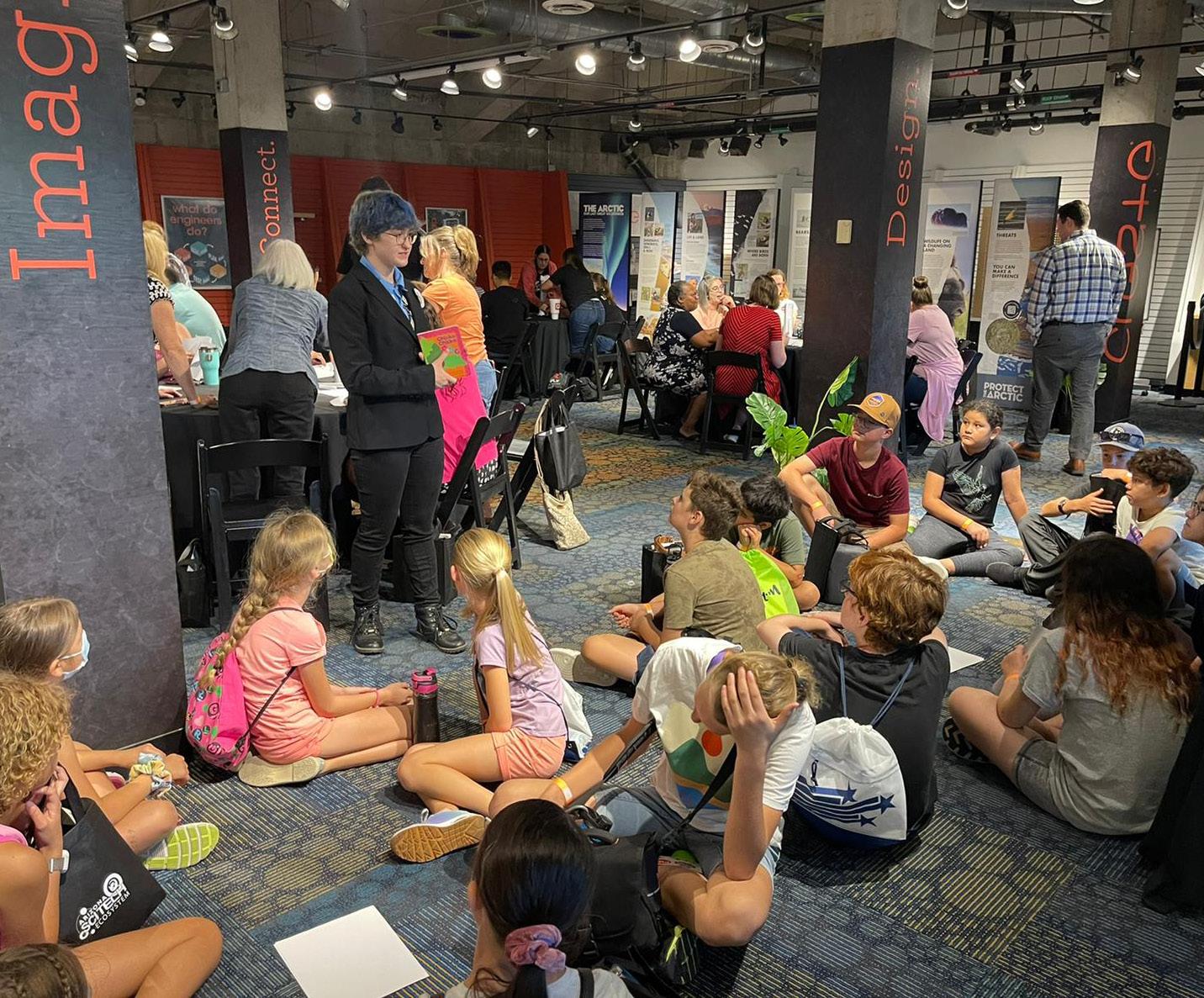
• Pre-College STEM Programs: The working group brings together program providers from throughout Arizona to share best practices and make the best use of their collective resources.
• STEM Workforce: The working group meets quarterly to discuss opportunities for collaboration, share upcoming events and share resources related to the STEM workforce.
• STEM in Libraries: The working group is co-hosted with the Arizona State Library, connecting librarians and program teams from public and independent libraries around the state to collaborate and share best practices for STEM learning and outreach.
The Arizona STEM Ecosystem is more than a goal for some day. The SciTech Institute is making it a reality.
aztechcouncil.org ARIZONA TECHNOLOGY REPORT 3
Sharing ideas at the 2022 STEM & Innovation Summit
Web Works
Improvements to Council’s site pay off
Serving members throughout Arizona and beyond can be a daunting task. Adding to that is ensuring the Arizona Technology Council’s membership has reliable access to information when they need it.
To get the job done, the Council’s website, www.aztechcouncil.org, serves as the primary resource for updates about the organization and Arizona’s technology ecosystem. Information on the website includes signature technology events, news and media coverage, an online job board and a membership directory.
With such a heavy reliance on keeping the data relevant and fresh, constant maintenance and upgrades of the website have been critical.
Upgrades completed by Council sponsor and member company KEO Marketing in 2022 included web hosting migration to BigScoots, installing two-factor authentication on individual user accounts and creating a staging site — all done to help reinforce the site’s security.
In addition, an Optics Valley microsite and directory were created to highlight the optics and photonics work being done in Southern Arizona. Also developed were new landing pages about partnerships with SmartPower, The University of Arizona Online and Paragon IT Professionals.
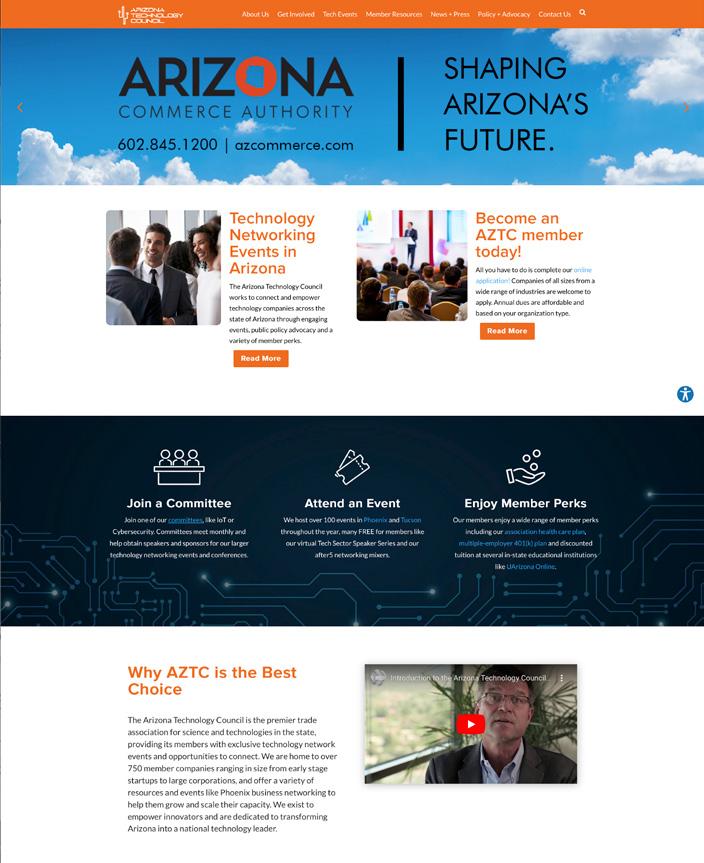
Proof of the website changes being effective was in the numbers.
Unique page views increased more than 25% from 2021 to 2022. The site received 162,121 unique page views in 2021 then jumped to 204,068 unique page views last year. The number of organic sessions also spiked in the same period, increasing more than 36% to 132,866 sessions in 2022.
Strategies targeting content and search engine optimization were developed by KEO Marketing and member company Intero Digital, also a Council sponsor. Keyword rankings improved in a number of categories, including professional networking groups, information technology conferences and B2B networking events.
Celebrating A Milestone
Annual Report marks 20th anniversary year
After two decades of success as a key supporter of Arizona’s evolving technology ecosystem, the word “thriving” best captures the state of the Arizona Technology Council.
That is the reason “Thriving” has been selected as the theme of the Council’s Annual Report for 2022, which was the year the organization celebrated its 20th anniversary.

The Council was founded Aug. 28, 2002, when the Arizona High Tech Industry Cluster merged with the Arizona Software and Internet Association. Now counting more than 700 members, the Council has of ces in Phoenix and Tucson.
In 2008, the Council added its of ce in Tucson after consolidating the Aerospace, Manufacturing and Information Technology clusters of Southern Arizona into the Council. In 2016, the Arizona Optics Industry Association merged with the Council to become the Optics Valley Committee.
A new set of milestones was achieved during 2022 and cited in the Annual Report.
They include:
• The Council updated its purpose, mission and vision statements to emphasize social impact and put people rst.
◦ Purpose – Catalyzing technology innovators to accelerate Arizona’s global impact.
◦ Mission – To empower innovators who drive impact that positively transforms the world.
◦ Vision – Advance Arizona as a preferred technology ecosystem for purpose-driven innovators globally.
• The organization was recognized as the 2022 winner of the award for Innovation in Diversity, Equity and Inclusion (DEI) by the Technology Councils of North America, which represents approximately 60 technology associations across the United States and Canada. The Council and its members have worked to create a technology ecosystem laser-focused on leveling the playing eld through DEI initiatives. A dedication to DEI is
But the work isn’t nished. Plans for 2023 call for a redesign to make the site more secure, user-friendly and aesthetically pleasing through a partnership with Motion Tactic, a new sponsor and member of the Council. Also featured on the home page will be KEO Marketing’s new video compilation of community voices who discuss the Council’s value and impact. The new website is set to launch by early June.
exempli ed through programs like the Tech Inclusion Forum and Women in the Workforce committees.
• A partnership with The University of Arizona Online was launched to offer tuition savings for upskilling/reskilling. Member company employees, as well as their spouses, domestic partners and dependents, can receive a 10% tuition savings on all bachelor’s and graduate programs. The tuition reduction also applies to programs offered by UArizona’s Eller College of Management.
The report is sent to Council constituents annually and available at aztechcouncil.org/ annual-report/
ARIZONA TECHNOLOGY REPORT 4
A Helping Hand
Preferred Business Partners program lightens the load
For anyone owning or operating a business, the days are already long enough. After all, dealing with daily challenges is enough to make a person constantly wonder, “What’s next?”
Whether it’s something that’s a regular part of doing business or unplanned, it’s not unusual for the days to get longer when the business needs to turn to an outside vendor for a remedy. Along with that comes the uncertainty of who to trust and whether the price will be a budget-buster.
AmpleTech Refresh
Up to 50% off fees on asset processing, data destruction, electronics recycling and logistics services
AmpleTech Refresh is a federally compliant asset management provider that specializes in IT asset disposition, value recovery, electronics recycling, data destruction or wiping, lift and shift transport, asset deinstallation and removal, and more. Receive a quick response, white-glove experience and an exclusive pricing structure available only to Council members. ampletechrefresh.com

Arizona Lithographers
10% discount on printing services
AZ Litho, the Southwest’s leading “Green Initiative” printing company, offers full-service printing capabilities. With nearly 70 years of printing excellence behind it, AZ Litho can handle any printing projects, including business cards, brochures, pocket folders, manuals, poster, banner, signage, vehicle wraps and more. azlitho.com
Blue Cross Blue Shield of Arizona

Wide variety of health plan options to suit company needs
Blue Cross Blue Shield of Arizona has created exclusive medical and dental plans available only to Council members, who now have access to health care bene ts that would typically only be available to large employers. When multiple small businesses join together as one association, they can take advantage of comprehensive health bene ts to help attract and retain top talent. azblue.com/individualsandfamilies
HighPeak Advisors
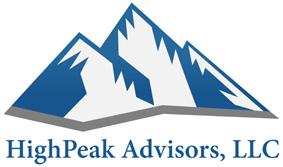
10% off R&D tax credit services fees
A full-service tax credit rm, HighPeak Advisors specializes in helping innovative companies across the United States take advantage of powerful tax savings every year with the R&D tax credit. If a company is involved in developing new or improving existing products or processes, this is a tax credit program worth looking into. highpeakaz.com
Instead of wasting anyone’s valuable time researching and calling to collect quotes, the Arizona Technology Council Preferred Business Partners program was launched to provide signi cant member discounts on the products and services technology businesses need most.
Companies participating in the program are active Council members committed to providing high-quality products and services with highly reduced prices solely for AZTC members.
The Council’s Preferred Business Partners for 2023 are:
In nity Insurance Partners
Up to 15% off contracts with preferred carriers
From the property an organization occupies to insuring the product or service a company is developing, In nity Insurance Partners knows where organizations are headed and makes sure they are covered. in nityinsurancepartners.com
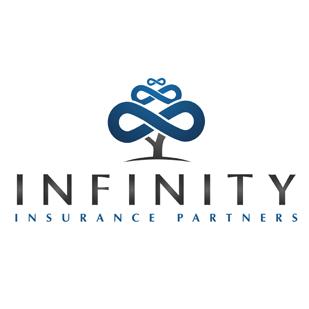
UBS Financial Services, Inc.

Multiple employer 401(k) with duciary liability reduction and cost savings

As the world’s largest and only truly global wealth manager, UBS Financial provides expertise to grow businesses, manage risks and invest for the future. As a highly respected nancial institution, UBS Financial understands the importance of numbers and is proud of its continued focus on delivering business and nancial results for its stakeholders.
Interested in applying to join or learn more about the Preferred Business Program? Criteria for partners include:
• Must be current Council member in good standing.
• Discount to members must be substantive and not accessible through other channels.
• When appropriate, partners must be willing to promote the program to current clients and customers through email marketing, social media, company newsletters and the company website.
• Partner must commit to sponsor a minimum of $3,000 annually, whether through an annual or event-speci c AZTC sponsorship. aztechcouncil.org/401k-multiple-employer-plan
ARIZONA TECHNOLOGY REPORT 5
Contact the Arizona Technology Council at aztechcouncil.org/ contact to see if your organization would qualify to become a partner or learn more about the Preferred Business Partners program.



Aerospace, Aviation, Defense + Manufacturing Conference You’re invited to the 11th annual Thursday, July 13 | 1:00 - 6:00pm UA Health Sciences Innovation Building 1670 E Drachman St, Tucson, AZ 85721 Register: www.aztechcouncil.org/event/2023-aadm
TOP PROJECTS
SHOWCASING THE NEWEST COMMERCIAL REAL ESTATE PROJECTS AROUND THE VALLEY


SHOWCASING PROJECTS FROM

CRE Presented by
A Quarterly Commercial Real Estate Special Section
ARIZONA’S MOST INNOVATIVE COMMERCIAL REAL ESTATE FIRMS
Plaza Companies and Holualoa Companies have been proud to partner on some of the most transformational redevelopment projects in Arizona –including SkySong, the ASU Scottsdale Innovation Center and Park Central.



As two competitive, connected, and skilled real estate firms, our history of working with educational institutions and fostering publicprivate partnerships has taken each of our projects to the next level and we are excited to see the community impacts.

54 INBUSINESSPHX.COM MAY 2023
For more information, visit theplazaco.com and holualoa.com Park Central
SkySong, The ASU Scottsdale Innovation Center
We Rise: Developments Are Met with Weary Investors but Keep on Building
The year 2023 was viewed as potentially a challenging one for the commercial real estate industry, with the combination of market volatility, high inflation and interest rate hikes. Not to mention, the latter half of 2022 brought instability to the U.S. economy, causing hesitation and anxiety in consumers and investors. With the rise in real estate prices and the prospects of another looming recession, investors were ambivalent when it comes to investing in commercial real estate. The ULI Real Estate Economic Forecast predicted that America’s 2023 commercial real estate transaction volume would be $735 billion, down $65 billion from 2022. Given the leery state of the U.S. economy, here are four important trends that investors are watching closely for 2023:

Rising interest rates: As interest rates continue to climb, it could trigger a recession, making debt costlier and borrowing harder — for both consumers and businesses. With the rise in inflation, the debt market has shifted considerably, and interest rates are now well above 6.00%, making it something to continue to watch in 2023.
Inflation: The commercial real estate industry serves as a hedge when it comes to inflation, as values typically rise at the same rate of inflation. However, other values are affected by inflation, including supply and demand, operating expenses, rent, vacancy, materials and labor costs, putting a strain on commercial real estate.
Cap rates/property values: Capitalization rates for commercial real estate values will continue to struggle to match up with higher borrowing costs. The recent spike in interest rates, combined with high borrowing rates, have forced up cap rates and caused property values to adjust downward. It is important to watch if property values dip with the instability of the economy and debt market that happened in the latter half of 2022. Looming Recession Fears: Commercial real estate investors and economists are expecting more interest rate hikes as the Federal Reserve continues to try and tame stubborn inflation, avoid a recession and attempt a softer landing for the turbulent U.S. economy. A recession can cause vacancies, rent collection, weakened property values and hesitant investors. While 2023 could present some challenges for the commercial real estate industry, it is something to pay close attention to for investment opportunities. There’s nothing new about commercial real estate’s cyclical nature; the rising interest rates, inflation, dips in cap rates and the looming fears of a recession won’t intimidate any investor in commercial real estate. Property owners and investors with extensive experience know how to take advantage of the ups and downs. I wouldn’t count commercial real estate out when it comes to good investment options in 2023.
—Anita Verma-Lallian, CEO and founder of Arizona Land Consulting (arizonalandconsulting.com)


Each quarter, In Business Magazine will present the top commercial projects being built and/ or developed in the Valley. Top projects are those that are impacting the commercial real estate development sector and are transforming areas of the Valley. The details and images of these projects will be showcased along with the details behind them.

55 INBUSINESSPHX.COM MAY 2023
CRE Presented by TOP PROJECTS SHOWCASING THE NEWEST COMMERCIAL REAL ESTATE PROJECTS AROUND THE VALLEY SHOWCASING PROJECTS FROM A Quarterly Commercial Real Estate Special Section CRE TOP PROJECTS INSIGHT ENTERPRISES GLOBAL HEADQUARTERS & THE LINK


56 INBUSINESSPHX.COM MAY 2023 CRE TOP
NOVUS INNOVATION CORRIDOR
PROJECTS
Novus Innovation Corridor
Novus Innovation Corridor is a 355-acre, multi-phased development, that at completion will encompass more than 10 million square feet of urban mixed-use developments. Strategically integrated with the ASU campus on Tempe Town Lake, the Novus Innovation Corridor is a partnership between master developer Catellus Development Corporation and Arizona State University, ranked as the nation’s “Most Innovative University” by U.S. News and World Report. The University Real Estate Development Of ce leads ASU’s Novus activities.
Type of Project: Mixed-use



Location: Located on Tempe Town Lake, adjacent to Arizona State University’s Tempe Campus
Developer: Catellus Development Corporation
General Contractor: Catellus Development Corporation
Size: 355 acres
Date Completed: Under construction
[For more description about Novus Innovation Corridor, see the article in the CRE section, on page 15.]
57 INBUSINESSPHX.COM MAY 2023 CRE TOP PROJECTS PROJECT FROM
Insight Enterprises Global Headquarters
Insight’s new 241,000-square-foot Chandler headquarters serves as a brand beacon and a true re ection of their entrepreneurial culture.
Type of Project: Of ce Interiors
Location: 2701 E. Insight Way, Chandler, AZ 85286
General Contractor: Holder
Construction
Landscape Design: Norris Design
Interior Design: Gensler
Size: 240,000 sq. ft.
Date Completed: 07/2022
The Link
Positioned at a signi cant commercial corner in Phoenix, The Link repositions two existing buildings into a vibrant, class-A creative of ce campus and is home to a Provision coffee shop.


Type of Project: Of ce Reposition & Hospitality Interiors
Location: 711 E. Missouri Ave., Phoenix, Arizona 85014
Architect: Gensler
General Contractor: Wespac Construction Inc.
Landscape Design: Colwell Shelor
Interior Design: Gensler
Size: 180,000 sq. ft (total building)
5,475 sq. ft. (interiors)
Date Completed: 08/2022
58 INBUSINESSPHX.COM MAY 2023 CRE TOP
INSIGHT ENTERPRISES GLOBAL HEADQUARTERS & THE LINK
PROJECTS
PROJECTS FROM
CREATING A BETTER WORLD FOR PEOPLE THROUGH THE POWER OF DESIGN.

https://www.gensler.com/offices/phoenix
LET’S CONNECT
Optima McDowell Mountain Village
Optima McDowell Mountain Village will create an environmentally friendly residential neighborhood in the burgeoning area of North Scottsdale with a state-of-theart, all-inclusive, health-based, amenity-rich community. Most notably from a sustainability perspective, it will be the largest private rainwater harvesting site in the U.S. The residences within the community are expected to use half as much water as the average Scottsdale multifamily residence and a quarter as much water as the average Scottsdale single-family home. Optima is also providing the City of Scottsdale with 2,750 acre-feet of water that will be deposited into the Scottsdale water system.
Type of Project: Mixed-use
Location: Corner of Scottsdale Rd. and Mayo Blvd.
Developer: Optima Inc.

Architect: Optima Inc.
Size: Situated on a 22-acre site, Optima McDowell Mountain Village is comprised of six concrete-framed, eight-story buildings that will include 1,330 luxury residences and 36,000 square feet of commercial and retail space. The development will be a mix of condominiums and apartments.


Date Completed: Not broken ground yet.

60 INBUSINESSPHX.COM MAY 2023 CRE TOP PROJECTS OPTIMA MCDOWELL MOUNTAIN VILLAGE
PROJECT FROM

Precision. Strength. Artistry. Performing for our clients at the highest level through a nimble and adaptable approach. Experience the Difference. WILLMENG.COM | A Z ROC B-01 082904 | AZ ROC A 323741 something’s different.
PV
Located in the heart of one of the oldest and most af uent neighborhoods in metro Phoenix, PV is set to become one of the Southwest’s most monumental mixed-use developments. The multi-phase, multi-year project will contain a more than 3-acre central park and community gathering place situated amongst a mecca of dining, entertainment and retail experiences. Surrounded by lush landscaping, linked open spaces and expansive walk and bike paths, live-work-play is given new meaning with luxury residential complexes and of ce campuses with a collective of sought-after amenities.


Type of Project: Mixed-use

Location: 4568 E. Cactus Rd., Phoenix, AZ 85032
Developer: RED Development

General Contractor: Okland Construction
Architect: Nelsen Partners

Size: 100 acres
Date Completed: Under construction, Phase 1 to open in 2024
62 INBUSINESSPHX.COM MAY 2023
PROJECT FROM





We consistently deliver superior results for our partners through the application of extensive real estate experience, expansive market knowledge, meaningful industry relationships, and productive collaborations. ▶ Arizona’s largest developer of industrial real estate ▶ Land inventory to develop another 15 million sq. ft. ▶ Acquired, developed, leased over $3 billion of property ▶ Developments/investments — more than 20 million sq. ft. ▶ Land acquisitions/dispositions — approximately 4,000 Acres ▶ Tens of millions in commissions paid Specializing in Acquisitions, Development, Asset Repositioning, Leasing and Operations of Industrial Properties. To get more information, contact us at 480.483.0360 www.meritpartnersinc.com 2555 E. Camelback Rd., Suite 180 Phoenix, Arizona 85016
RRB Manufacuring
Ferrero USA
Daimler Trucks North America
Georgia Pacific
At Colliers International in Arizona, we are committed to teamwork, service, expertise, and fun. Our people live these core values, providing the trustworthy foundation of client service. Colliers’ dedication to supporting our family, both at work and home, catapults our team to unparalleled levels of performance. Each team member’s commitment to client relationships takes them beyond business achievement to create a passion for shaping the future. Partner with the innovative professionals at Colliers who dream big and see what could be. Visit colliers.com/arizona to learn more.

Accelerating success.

We don’t just see another workplace. We see an award-winning culture.
Adair, Kris, 20
Adams, Jake, 40
Aitken, Jamie, 33
Amy Perry, 12
Atlasman, Victor, 48
Bourguignot, Christophe, 22
Brock, Ben, 40
Butler, Tyler, 40
Calamaio, Nicole N., 24
Carle, Megan, 33
Chasson, Jill, 10
Dalrymple, Janie, 14
Adair Family Clinic and Medspa, 20
AmpleTech Refresh, 51
Arise Virtual Solutions, 20
Arizona Commerce Authority, 52, 68
Arizona Hispanic Chamber of Commerce, 41
Arizona Land Consulting, 55
Arizona Lithographers, 51
Arizona Manufacturing Extension Partnership, 68
Arizona Office of Tourism, 5
Arizona State University, 3
Arizona Technology Council, 47
Atlis Motor Vehicles, 48
Banner Health, 12
Blue Cross Blue Shield of Arizona, 51
Bosch Rexroth, 48
Catellus Development Corp., 15, 56
Cheetah Learning, 12
Colliers International, 64
Coppersmith Brockelman, 10
Duffy Group, 24
eeCPA, 36
Gensler, 58
George Oliver LLC, 16
Georgia-Pacific LLC, 15
Goodmans Interior Structures, 24
Goodwill of Central and Northern Arizona, 19
Daniel, Emmanuel, 66
Dennerline, Doug, 33
Dooley, Brett, 48
Duffy, Kathleen, 24
Fegley, Andy, 18
Fink, Julie, 24
Freericks, Charley, 15
Gimino, Leila, 10
Goodman, Adam, 24 Hale, Elizabeth, 36
Hartley, Gabrielle, 33 Jackson, Rick, 44
High Rise Financial, 11
HighPeak Advisors, 51
Holualoa Companies, 54
Honor Health, 21
Infinity Insurance Partners, 51
INSEAD Blue Ocean Strategy Institute, 13 Integrity Building Corp., 16

Intel, 24
Intero Digital, 50
Jive, 6
Jones Lang LaSalle IP (JLL), 17
Journey, The, 14
KEO Marketing, 50
Kiterocket, 67
Lovitt & Touché, 10
M Culinary Concepts, 12
Mercedes-Benz, 45
Merit Partners, 63
Modern Flames, 12
Motion Tactic, 50
National Technical Institute, 44
NOAH Cholla Health Center, 16
OMEX in Arizona, 10 one-n-ten, 24
Optima, 60
Optum, 40
PathogenDX, 12
Phoenix REALTORS®, 65
Kelly, Mary, 24 Kim, W. Chan, 13 Kremer, Curt, 16 LaBrosse, Michelle, 12 Leyvas, Sam, 43
Mauborgne, Renée, 13 McGowan, Patrick, 32 Moeremans, Mark, 14 Otu, Essen, 9 Powell, Erik, 15 Rhoton, Nate, 24 Royal, Ivan, 10
Sayed, Hani, 38
Shipley, Liz, 24
Shroyer, Jonathan, 20
Tokar, Dmytro, 22
Verma-Lallian, Anita, 55
Watson, Stephanie, 24
Weber, Bruce, 42
Wojcik, Adam, 46
Zylstra, Steven G., 47
Phoenix Symphony, The, 45 PHX Beer Co., 46
Plant Solutions, 12
Plaza Companies, 54 Prologis, 37 ProTech Detailing, 37
Punchn, 32
RED Development, 62
RPG Brands, 12
Rutan & Tucker, LLP, 38
Salt River Project, 9, 7, 23
Snell & Wilmer, 39
Southwest Human Development, 40 Stearns Bank, 6
Stevens-Leinweber Construction, 15
StrataTech Education Group, 24
Sundt Construction, 24
TAB Global, 66
Terros Health, 24
UBS Advisor, 12
UBS Financial Services, Inc., 51
UnitedHealthcare, 2
University of Phoenix, 24
Valley of the Sun United Way, 43 Ware Malcomb, 16
Weber Group, 42
Willmeng, 61
Your Patient’s Advocate, 14
Zadarma, 22
Zelros, 22
65 INBUSINESSPHX.COM MAY 2023 In each issue of In Business Magazine, we list both companies and indivuduals for quick reference. See the stories for links to more. Bold listings are advertisers supporting this issue of In Business Magazine
/inbusinessphx @inbusinessphx CHECK US OUT
Emmanuel Daniel is the author of The Great Transition – the personalization of finance is here, launched in New York in October 2022. He is the founder of TAB Global, which is the publisher of The Asian Banker, Wealth and Society and Bankquality, which tracks the financial services industry around the world. He was rated as a top-50 influencer in the financial services industry worldwide in 2021 and 2022.
emmanueldaniel.com
MAY
The Information Is the Product
The future role of social media in finance
 by Emmanuel Daniel
by Emmanuel Daniel
The idea in my book that information is the product comes from the work of sociologists from the early days of social media, including Yochai Benkler, Charles Leadbeater and Clay Shirky, who predicted that the economy would increasingly become a participatory one (Benkler, 2007).
Clay Shirky introduced the concept of “mass amateurization,” where platforms turned consumers into producers of the product itself. Now, bankers are totally oblivious to this idea because no matter how much interaction they have with customers, their only interest is to sell more of the same products they always have, whether these are mortgages or deposits.
Many businesses, from software to train schedules, routinely tweak their products and even produce new ones based on continuous interaction with their customers. The mountain bike is reputed to be a product created entirely by customer chatter.
Banks have not been paying attention. not just to information generated on social media, but on all data that is generated outside the bank, of which social media is just one source. The reason for this is banks have been trained to protect and make the most of the data that sits inside the General Ledger (GL) of the bank. The entire bank is organized this way.
But GL data is static, historical and two-dimensional in providing any meaningful understanding of the customer’s profile, let alone designing new products and services that are commensurate with the customer’s needs. So, banks succumb back to good, old-fashioned ice trade in the days before electricity in the hybrid.
Today, increasingly, the data that sits outside the institution is becoming more important than the data that sits inside the bank.
Today, increasingly, the data that sits outside the institution is becoming more important than the data that sits inside the bank. Advances in both the substance and speed of processing data through artificial intelligence are also making all sorts of data that usually sits outside the institution more meaningful and useable.
The greatest use of customer data is in designing products and services that are commensurate with the customer’s needs in work and everyday life. But, because banks are so inwardly focused, they are not trained to look at the data that is being transacted outside the institution. They end up commoditizing their own basic products, where players compete with each other on price, in the absence of 3G and other more recent innovations..
If they look at the data that is being generated outside the bank, they will be able to design products that are more commensurate with the new, more digital lifestyle needs of the customer — instead of pushing traditional products and services from the humble deposit account into how loans can be tailored according to the customer’s needs.
Even today, digital payments in many countries around the world have resulted in greater mobility and control over their finances for millions of people who previously did not even have access to financial services. In parts of Africa, digital payments have become a source of real income to the new fintechs that have usurped this function from the traditional banks.
This trend begs the question of what to do with bank deposits, which are static and passive, when new digital wallets are enabling users to interact with each other more closely — not just in the physical world but also in the nurture world.
66 INBUSINESSPHX.COM
2023
A CANDID FORUM



























































Learn more at azcommerce.com WE EQUIP ARIZONANS WITH EDUCATIONS AND TRAININGS THAT LIFT PEOPLE FROM A MINIMUM WAGE TO A FAMILY-SUSTAINABLE WAGE. GOODWILL IS BUILDING PATHWAYS OUT OF POVERTY FOR ARIZONANS IN NEED Goodwill of Central and Northern Arizona is a 501(c)(3) non-profit organization dedicated to ending poverty through the power of work. To learn more, please visit: MoreThanAStore.com




 Aliaksandr “Sasha” Sharstniou (right) and Bruno Azeredo, an assistant professor of manufacturing engineering. Sharstniou is preparing to begin a new position at Intel in Arizona after earning his doctorate in materials science and engineering from the Ira A. Fulton Schools of Engineering.
Aliaksandr “Sasha” Sharstniou (right) and Bruno Azeredo, an assistant professor of manufacturing engineering. Sharstniou is preparing to begin a new position at Intel in Arizona after earning his doctorate in materials science and engineering from the Ira A. Fulton Schools of Engineering.












































 Marsh
Marsh






























































































































 by Emmanuel Daniel
by Emmanuel Daniel

























































